- Skip to main content
- Keyboard shortcuts for audio player

Pope Benedict XVI Visits the U.S.
- Subscribe to NPR's Up First Email
Pope Tweaks His Image on Six-Day Trip to U.S.
April 21, 2008 • Pope Benedict XVI ended his six-day trip to the United States with a Mass in New York. When the pope arrived last week, most American Catholics knew little about him. But the 81-year-old pontiff seems to have changed his image and America's vision of the Roman Catholic Church.
Composing for the Pope: A Church Music Primer
April 20, 2008 • Throughout history, the papacy has been a powerful patron of music, from Gregorian chant to modern Masses. Historian Robert Greenberg notes that much of the finest music has come from composers associated with the Sistine Chapel.
Benedict Holds Stadium Mass for N.Y.C. Faithful
April 20, 2008 • Pope Benedict XVI concluded his U.S. visit today with a tour of New York City. The pontiff stopped this morning at Ground Zero and gave a blessing at the site of the Sept. 11, 2001, terrorist attacks there. In the afternoon he presided over a Mass for a capacity crowd at Yankee Stadium.
Pope Pays Solemn Visit to New York's Ground Zero
April 20, 2008 • Pope Benedict XVI wraps up his first trip to the United States with a visit to Ground Zero in New York City. Correspondent Mike Pesca talks with Liane Hansen about the mood as the pope prayed at the site of the terrorist attacks on the World Trade Center.
Pope Delivers Serious Message to Young Catholics
April 20, 2008 • Pope Benedict XVI joined 20,000 teens at a rally in Yonkers, N.Y., Saturday night. Benedict's predecessor, John Paul II, was extremely popular with young Catholics. The rally's atmosphere was light, but the current pope's message was not.
Nun Weighs in on Pope's U.S. Visit
April 20, 2008 • Sister Joan Chittister, a Benedictine nun from Erie, Pa., talks to Liane Hansen about Pope Benedict XVI's visit and reacts to his meeting with the clerical victims of sexual abuse and his opinions on the role of women in the Catholic Church.
Pope Urges Youth to Have Hope in Jesus
April 19, 2008 • Pope Benedict XVI continues his tour of the United States on Saturday. He began the day with a Mass at St. Patrick's Cathedral in New York City and then spent the afternoon at a mass rally for young people. His opening act? Kelly Clarkson.
Is Pope Signaling Change in Abuse Policy?
April 19, 2008 • In his first visit to the U.S., Pope Benedict XVI has addressed the issue of clergy sex abuse several times. Canonical law expert Nicholas Cafardi says he sees signs that the pope may be weighing changes to church law that will make it easier to deal with the abuse problem.
Pope Pleases Faithful on U.S. Trip
April 18, 2008 • Pope Benedict XVI wins support with his warm demeanor during a visit to the U.S. His speeches to bishops and Catholic educators and his meeting with victims of clergy sexual abuse, have pleased both conservatives and liberals.
Pope Addresses U.N. on Human Rights
April 18, 2008 • Pope Benedict XVI told U.N. delegates that strengthening human rights is the key to solving the world's problems Friday.
Alex Chadwick and Madeleine Brand
Pope lauds human rights, cooperation at u.n..
April 18, 2008 • Pope Benedict XVI told the U.N. General Assembly that strengthening human rights should be the key to solving the world's problems and that nations should guard against a relativistic interpretation of moral principles. Later Friday, Pope Benedict will make history as he becomes the first pontiff to visit an American synagogue.
Pope's Meeting with Abused Disturbs Some Victims
April 18, 2008 • As Pope Benedict XVI continues his first visit to the United States as pontiff, he met Thursday with victims of sexual abuse by Catholic priests. Other victims were outraged that the pope would meet with such a small, hand-picked group.
Pope to Educators: Catholic Identity is About Faith
April 18, 2008 • Pope Benedict met Thursday with a private audience of Catholic educators at Catholic University of America in Washington, D.C. His message was about the nature and cultivation of Catholic identity on campus.
Pope Meets with Victims of Clergy Sex Abuse
April 17, 2008 • Pope Benedict XVI met privately Thursday with a group of victims of sexual abuse by priests. Only a handful of victims from the Boston area were invited to the private discussion, which lasted about a half-hour, church officials said.
Sex-Abuse Victims Meet Quietly with Pontiff
April 17, 2008 • Pope Benedict XIV meets behind closed doors with at least two victims of the clergy sex-abuse scandal. The meeting took place after the public Mass on Thursday in Washington, D.C.
Pope Praises America at D.C. Mass
April 17, 2008 • Pope Benedict XVI praises America as a land of opportunity during his first public Mass in the U.S. Tens of thousands of worshippers filled the new baseball stadium in Washington, D.C., for an open-air service.
Why Does the Pope Wear Red Shoes?
April 17, 2008 • Pope Benedict XVI's ruby red shoes are drawing plenty of attention as he visits Washington, D.C. Lawrence Cunningham, professor of theology at the University of Notre Dame, offers insights on why the pontiff favors the color.
Clergy Abuse Victims Meet with Pope
April 17, 2008 • Pope Benedict XVI met Thursday with victims of clergy sexual abuse. Two victims spoke to NPR after the meeting about what they discussed with the pope and the changes they want to see in the Catholic Church.
Pope Draws Thousands to Mass
April 17, 2008 • More than 46,000 people attended Pope Benedict XVI's mass at Nationals Park in Washington D.C. Thursday.
Pope Conducts Mass with Thousands in Washington
April 17, 2008 • Pope Benedict XVI presided over an open-air Mass of 45,000 people at a Washington, D.C., baseball stadium, where hundreds of voices sang out to the masses during the pope's historic visit to the nation's capital. The German-born pope also acknowledged the pain and harm done to victims of priests caught up in a sex scandal.
Father Tom Reese and Lynn Neary
Talk with catholic educators on pope's d.c. agenda.
April 17, 2008 • Pope Benedict will address a group of Catholic educators Thursday about what it means to be a Catholic institution. First, though, he celebrated Mass with tens of thousands of worshippers in the nation's capital. It's part of his six-day visit to the U.S.
Mass with Pope Draws 46,000 to D.C. Stadium
April 17, 2008 • A Mass with Pope Benedict XVI will draw 46,000 people to the Nationals baseball stadium Thursday in Washington, D.C. The pope is spending six days in the United States. It's his first visit since becoming pontiff in 2005.
Lynn Neary and Barbara Bradley Hagerty
- Skip to main content
- Skip to secondary menu
- Skip to primary sidebar
- Skip to footer

Catholic Review
Inspiring the Archdiocese of Baltimore
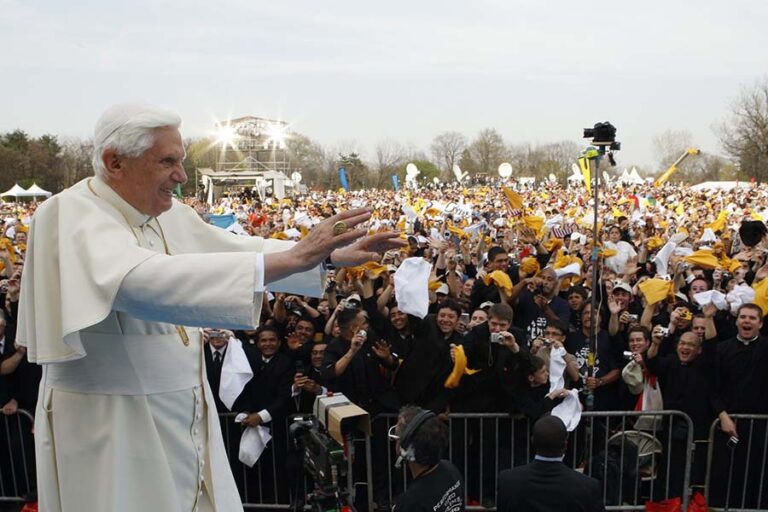
Pope Benedict’s 2008 U.S. visit a whirlwind with timely, pointed messages

WASHINGTON (CNS) — When Pope Benedict came to the United States for a visit to Washington and New York spanning six days in mid-April 2008, some news accounts called the pace of his schedule “grueling.”
Pope Benedict handled the pace with good grace while getting his message out to millions of Catholics both in the United States and throughout the world. He died at the Vatican Dec. 31.
The trip had been timed to help celebrate the bicentennials of four archdioceses in the United States: New York, Boston, Philadelphia, and Louisville, Ky. They were erected from the Baltimore Diocese, the nation’s first diocese, which was elevated to an archdiocese in the same year, 1808.

But it was the abuse crisis, which burst onto front pages in 2002 and persists to this day, that was a central focus of Pope Benedict’s trip; this was the first papal visit since the scandal started making headlines in the U.S.
At a Mass at the brand new Nationals Park in Washington, Pope Benedict said that “no words of mine could describe the pain and harm inflicted by such abuse. It is important that those who have suffered be given loving pastoral attention.”
The pope lauded the efforts to deal “honestly and fairly with this tragic situation and to ensure that children — whom Our Lord loves so deeply and who are our greatest treasure — can grow up in a safe environment.”
“I encourage each of you to do what you can to foster healing and reconciliation and to assist those who have been hurt. Also, I ask you to love your priests, and to affirm them in the excellent work that they do,” he said.
Later that day, he met privately with a group of abuse survivors at the apostolic nunciature; the meeting was a first for a pope.
Pope Benedict’s Washington itinerary included an audience with the U.S. bishops and an appearance at The Catholic University of America, the nation’s papally chartered university, to speak to educators. He also presided over a vespers service at the Basilica of the Shrine of the Immaculate Conception.
The pope met with President George W. Bush inside the White House, emerging to cheering throngs outside as the pope and the president exchanged greetings.
In his meeting with the bishops, Pope Benedict acknowledged the “evil” of the clerical sexual abuse crisis and encouraged them to continue their work to restore trust in the church and its ministers.
Talking to educators at The Catholic University of America, he said today’s challenges require sound instruction in the faith, especially among the young. But they also call for “cultivating a mindset, an intellectual culture, which is genuinely Catholic” and can bring the Gospel to bear on the urgent issues American society faces.
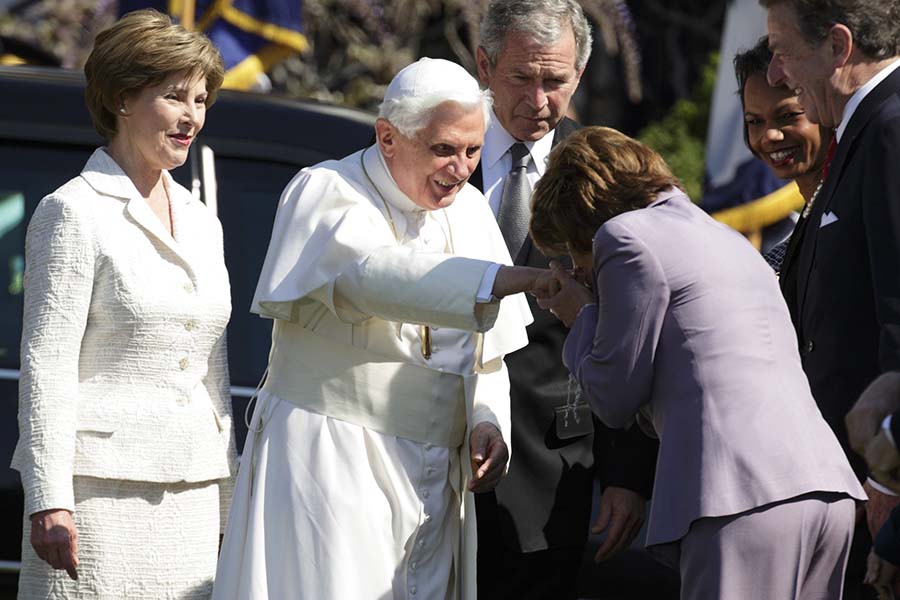
Before heading to New York, Pope Benedict met with 200 representatives of Islam, Jainism, Buddhism, Hinduism and Judaism gathered at the Pope John Paul II Cultural Center, and on his way to an ecumenical prayer service in Manhattan, Pope Benedict stopped to greet Jewish leaders at the Park East Synagogue.
At the synagogue, Pope Benedict expressed his respect for the city’s Jewish community and encouraged the building of “bridges of friendship” between religions. The encounter marked the first time a pope had visited a Jewish place of worship in the United States, and it came a day before the start of Passover.
At the ecumenical prayer service, Pope Benedict said the witness of Christians in the world is weakened not only by their divisions, but also by some communities turning their backs on Christian tradition.
“Too often those who are not Christians, as they observe the splintering of Christian communities, are understandably confused about the Gospel message itself,” he said.
He also praised the ecumenical commitment of U.S. Christians and acknowledged that the agreements found in their theological dialogues have contributed to the theological agreements later forged by the Vatican and its official dialogue partners.
Celebrating Mass in New York’s St. Patrick’s Cathedral with thousands of priests and religious, the pope urged the Catholic Church in the United States to move past divisions and scandal toward a “new sense of unity and purpose.” It is time, he said, to “put aside all anger and contention” inside the church and embark on a fresh mission of evangelization in society.
Honoring the bicentennial of four U.S. archdioceses, Pope Benedict praised the “solid foundations” of the American Catholic Church and said that “the future of the church in America” must continue to build on that “impressive legacy.”
But in his homily for the final U.S. Mass, celebrated at Yankee Stadium, he also said the “impressive growth” of the U.S. church has been “not without its challenges,” comparing those challenges to the “linguistic and cultural tensions” found in the early church.
“In these 200 years, the face of the Catholic community in your country has changed greatly,” Pope Benedict said. “We think of the successive waves of immigrants whose traditions have so enriched the church in America.”
He also lauded “the strong faith which built up the network of churches, educational, health care and social institutions which have long been the hallmark of the church in this land,” as well as “those countless fathers and mothers who passed on the faith to their children, the steady ministry of the many priests who devoted their lives to the care of souls, and the incalculable contribution made by so many men and women religious.”
In a speech to the U.N. General Assembly, Pope Benedict said neither government nor religion has a right to change or limit human rights, because those rights flow from the dignity of each person created in God’s image. The pope insisted that human rights cannot be limited or rewritten on the basis of national interests or majority rule.
He also said the role of religions is not to dictate government policy, but to help their members strive to find the truth, including the truth about the dignity of all people, even if their religious views are different.
Two years after his U.S. visit, Pope Benedict sat down for an interview with German journalist Peter Seewald. The interview became the basis for a book, “Light of the World: The Pope, the Church and the Signs of the Times.”
Speaking of the visit, when the abuse crisis was center stage, Pope Benedict said: “I think even non-Catholics were surprised that the visit was not some kind of challenge.”
The pope said that at every appointment on his trip, including the liturgies in New York and Washington, there was “joyful participation, a sense of closeness, of communion, that touched me greatly.”
Asked whether the church in the United States had already surmounted the abuse crisis, Pope Benedict replied, “That might be an exaggeration.” But, he added, the crisis made the U.S. church in the United States “aware of its fragility and of the problems and sin that are present in it. This is very important. In addition, there is an internal awakening to the need to overcome all these things and to live out and embody Catholic identity in new ways in our time.”
Read More Vatican News
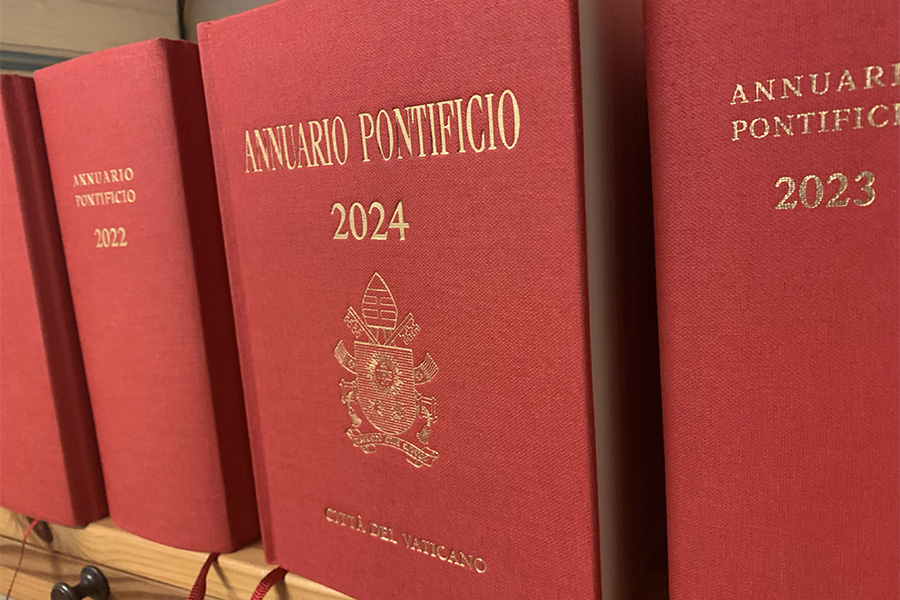
- ‘Patriarch of the West’ reappears as papal title in Vatican yearbook

- Pope asks Bible scholars to highlight Jesus’ care for those who suffer

- Pope condemns culture that views people with disabilities as ‘burdens’

Explainer: What are indulgences?

Take evil seriously, pope says at general audience
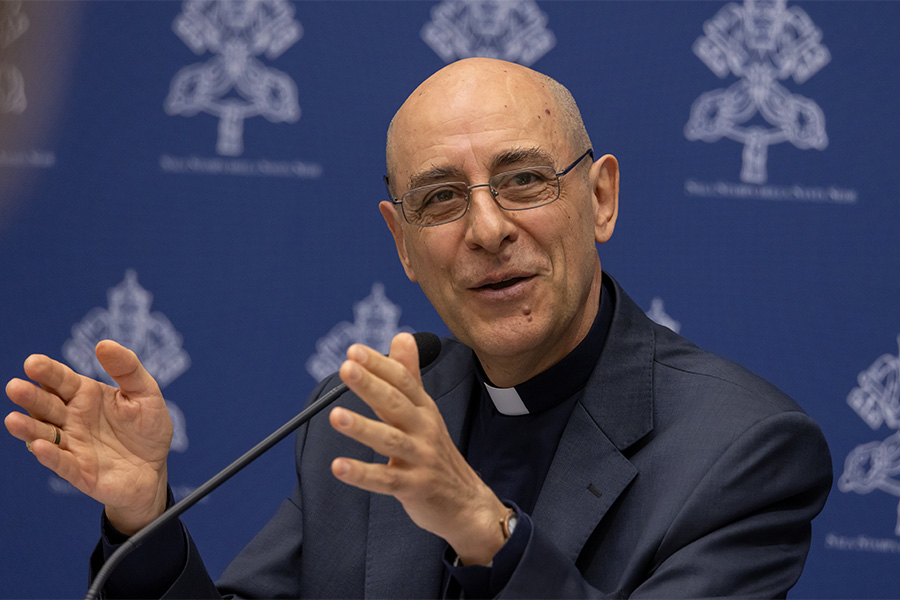
Old truth, new insight: Cardinal says human dignity text is result of growth
Copyright © 2022 Catholic News Service/U.S. Conference of Catholic Bishops
Real Life. Real Faith.
Catholic Review Media communicates the Gospel and its impact on people’s lives in the Archdiocese of Baltimore and beyond.
Our Mission
Catholic Review Media provides intergenerational communications that inform, teach, inspire and engage Catholics and all of good will in the mission of Christ through diverse forms of media.
Catholic Review 320 Cathedral Street Baltimore, MD 21201 443-524-3150 [email protected]
Social Media
- Priests have worldwide reach in serving as national Eucharistic preachers
- U.S. bishops’ pro-life chair: ‘Dignitas Infinita’ speaks truth in love with ‘clarity’
- St. Teresa of Kolkata’s motherly wisdom
- ‘We share their pain’: Archbishop Pérez on mass shooting at Philadelphia Islamic celebration
- Sister Doris Johnson, former teacher at Little Flower and St. Elizabeth, dies at 84
- ‘Irena’s Vow,’ Heroism in the Face of Evil

Catholic Media Assocation
Maryland-Delaware-DC Press Association
The Associated Church Press
Share this on:
- Story Highlights
- Next Article in U.S. »
NEW YORK (CNN) -- Pope Benedict XVI concluded his six-day visit to the United States with a final address Sunday, thanking Americans for their hospitality and calling on people worldwide to pursue "justice and peaceful coexistence."
Before his departure, the pope encouraged "peaceful coexistence between people and nations."
"It has been a joy for me to witness the faith and devotion of the Catholic community here," the pontiff told a cheering crowd of more than 3,000 at New York's John F. Kennedy International Airport on Sunday night.
"It was heart-warming to spend time with leaders and representatives of other Christian community and other religions."
The pope was introduced by Vice President Dick Cheney, who said, "It's been a memorable week, and Pope Benedict XVI has stepped into the history of our country in a very special way."
"You've encountered a nation facing many challenges but with more blessings than any of us could number," Cheney told the pope, adding later, "You will always be welcome."
The pontiff told the crowd that his visit earlier in the day to Ground Zero -- the site of the September 11, 2001, terrorist attacks -- "will remain firmly etched in my memory, as I continue to pray for those who died and for all who suffer in consequence of the tragedy."
He said his visit to the General Assembly of the United Nations was one of the "high points" of his visit.
"I encourage people of goodwill everywhere to continue working tirelessly to promote justice and peaceful coexistence between people and nations," the pope said before his departure.
- Audio slideshow: Pope visits New York
- Pope connects with new generation
- Pontiff recalls 'monster' Nazi regime
- iReport: See the scene outside Yankee Stadium
Addressing the audience at Yankee Stadium, Benedict called on his flock not to lose heart "in the face of resistance, adversity and scandal," and encouraged followers to reject "a false dichotomy between faith and political life."
"'Authority,' 'obedience' -- to be frank, these are not easy words to speak nowadays. Words like these represent a 'stumbling stone' for many of our contemporaries, especially in a society which rightly places a high value on personal freedom," he said in a homily delivered during his last Mass in the United States as millions across the world watched on television.
Vatican analysts have said one of the 81-year-old pope's goals for his trip was to help keep American Catholics in the flock, as many have left the church in recent years.
An influx of Latino Catholics has boosted the overall U.S. Catholic population. Parts of Sunday's service were in Spanish.
"In this land of religious liberty, Catholics found freedom not only to practice their faith, but also to participate fully in civic life," he said.
Polls show that about half of Americans who identify as Catholic support abortion rights. In a reference to that issue, the pope cited "the inalienable dignity and rights of each man, woman and child in our world -- including the most defenseless of all human beings, the unborn child in the mother's womb."
While he did not bring up the cases of abuse of young people by priests that have rocked the U.S. Catholic Church in recent years, the pope did mention "scandal."
"Praying fervently for the coming of the Kingdom also means being constantly alert for the signs of its presence, and working for its growth in every sector of society. It means facing the challenges of present and future with confidence in Christ's victory and a commitment to extending his reign. It means not losing heart in the face of resistance, adversity and scandal," he said.
Looking at the crowd filled with people of all ages, the pope had a message for those who could become the church's future leaders.
Pope prays at Ground Zero
Earlier Sunday, the pope prayed at New York's Ground Zero, asking God to bring healing and strength to grieving families, and direction for people "consumed with hatred."
At Ground Zero, he greeted dignitaries, including New York Gov. David Paterson, New York Mayor Michael Bloomberg and New Jersey Gov. Jon Corzine.
"We ask you in your goodness to give eternal light and peace to all who died here," Benedict said.
"We ask you, in your compassion, to bring healing to those who, because of their presence here that day, suffer from injuries and illness. Heal, too, the pain of still-grieving families and all who lost loved ones in this tragedy." he said.
The pope also prayed for "those who suffered death, injury and loss on the same day at the Pentagon and in Shanksville, Pennsylvania. Our hearts are one with theirs as our prayer embraces their pain and suffering."
He asked God to "bring your peace to our violent world -- peace in the hearts of all men and women and peace among the nations of the Earth."
He ended the prayer saying, "God of understanding, overwhelmed by the magnitude of this tragedy, we seek your light and guidance as we confront such terrible events.
"Grant that those whose lives were spared may live so that the lives lost here may not have been lost in vain."
All About Pope Benedict XVI • Roman Catholicism
From the Blogs: Controversy, commentary, and debate
Sit tight, we're getting to the good stuff.
Recommended
Breaking news, looking back at pope benedict xvi’s historic 2008 visit to new york and dc.
- View Author Archive
- Email the Author
- Follow on Twitter
- Get author RSS feed
Contact The Author
Thanks for contacting us. We've received your submission.
Thanks for contacting us. We've received your submission.

Mere hours after solemnly praying at Ground Zero for the victims of 9/11, Pope Benedict XVI got cheered like he was Derek Jeter while leading mass at Yankee Stadium.
The day was April 20, 2008, and it marked the conclusion of the late Pope’s historic six-day pilgrimage to the United States, which included spending the last three days in the Empire State and leaving many New Yorkers — among the state’s 7.3 million Catholics — feeling blessed.
“Benedict was something unique – a spiritual leader, a theologian, and someone who made me feel at peace and at ease,” recalled New York Building Congress President Carlo Scissura, who attended the pope’s gala sendoff back to Rome later that day at Kennedy Airport.
“It was a memorable experience for me personally. He was a true presence as a leader when you met him in person.”
Benedict made his lone trip to the US in part to apologize for a priest-abuse scandal that had scarred the Catholic Church, and he met behind closed doors with victims of pedophile priests.
He spent his first three days in Washington, DC, where he was greeted by then-President George W. Bush and discussed turmoil in the Middle East and other topics. The pope also celebrated turning 81 by having a crowd of 4,000 sing “Happy Birthday” to him on the White House lawn, and he held mass for more than 40,000 at Nationals Park.

On April 18, he arrived in Manhattan and addressed the United Nations General Assembly, where he warned of grave disparity between the haves and have-nots of the word. He also became the first Pope to visit a Jewish place of worship in the United States when he showed up on the eve of Passover at the Park East Synagogue.
Rabbi Arthur Schneier greeted Benedict warmly, declaring, “The sun is shining. The heavens are rejoicing on this day.”
The next day, Benedict visited St. Patrick’s Cathedral where held mass for 3,000, mostly clergy, and spoke about the child-sex abuse scandal and declared it a time for healing. He also met with more than 20,000 teens and young adults at a youth rally at St. Joseph’s Seminary in Yonkers, NY.

During his final day in New York, Benedict became the first pope to visit the former Twin Towers site in Lower Manhattan and bless the sacred soil of Ground Zero. He urged worldwide unity against terrorism and prayed with a handful of 9/11 survivors, victims’ relatives and first responders.
“He held my hands, and it was comforting. I thanked him very much for coming,” said Rose Mazza of Massapequa, LI, at the time. Mazza lost her daughter Kathy, a Port Authority Police captain, on 9/11.
“I can now talk about Kathy. Before this, I couldn’t. He brought closure to us,” Mazza said.
Advertisement

Benedict gave Mazza and others a memento of the experience: a cross cut out of steel from the fallen towers.
The Pope then headed north to the Bronx to visit what many sports purists consider baseball holy ground: Yankee Stadium.
White doves soared as the pontiff took his position in front of 57,000 faithful on a makeshift stand over second base. More than 200,000 had requested passes to the free event.
The papal seal covered the pitcher’s mound, and the crowd wildly waved handkerchiefs of white and gold – the Vatican’s colors – as Benedict entered to loud cheers like it was Game Seven of a World Series.

He was serenaded by everyone from Harry Connick Jr. to the Young People’s Chorus of New York City, and he left the “House that Ruth Built” to the strains of “Ode to Joy,” from Beethoven’s Ninth Symphony.
Before he boarded his flight at Kennedy Airport later evening, he told Scissura, then-Vice President Dick Cheney, then-Mayor Bloomberg and some 5,000 others in attendance: “It has been a joy for me to witness the faith and devotion of the Catholic community here.”
Before stepping onto an Alitalia Boeing 777 dubbed “Shepherd One,” Benedict exclaimed, “May God bless America!”
Share this article:


Pope Benedict’s 2008 U.S. visit a whirlwind with timely, pointed messages

When Pope Benedict came to the United States for a visit to Washington and New York spanning six days in mid-April 2008, some news accounts called the pace of his schedule “grueling.”
Pope Benedict handled the pace with good grace while getting his message out to millions of Catholics both in the United States and throughout the world. He died at the Vatican Dec. 31.
The trip had been timed to help celebrate the bicentennials of four archdioceses in the United States: New York, Boston, Philadelphia, and Louisville, Kentucky. They were erected from the Baltimore Diocese, the nation’s first diocese, which was elevated to an archdiocese in the same year, 1808.
But it was the abuse crisis, which burst onto front pages in 2002 and persists to this day, that was a central focus of Pope Benedict’s trip; this was the first papal visit since the scandal started making headlines in the U.S.
At a Mass at the brand new Nationals Park in Washington, Pope Benedict said that “no words of mine could describe the pain and harm inflicted by such abuse. It is important that those who have suffered be given loving pastoral attention.”
The pope lauded the efforts to deal “honestly and fairly with this tragic situation and to ensure that children – whom Our Lord loves so deeply and who are our greatest treasure – can grow up in a safe environment.”
“I encourage each of you to do what you can to foster healing and reconciliation and to assist those who have been hurt. Also, I ask you to love your priests, and to affirm them in the excellent work that they do,” he said.
Later that day, he met privately with a group of abuse survivors at the apostolic nunciature; the meeting was a first for a pope.
Pope Benedict’s Washington itinerary included an audience with the U.S. bishops and an appearance at The Catholic University of America, the nation’s papally chartered university, to speak to educators. He also presided over a vespers service at the Basilica of the Shrine of the Immaculate Conception.
The pope met with President George W. Bush inside the White House, emerging to cheering throngs outside as the pope and the president exchanged greetings.
In his meeting with the bishops, Pope Benedict acknowledged the “evil” of the clerical sexual abuse crisis and encouraged them to continue their work to restore trust in the Church and its ministers.
Talking to educators at The Catholic University of America, he said today’s challenges require sound instruction in the faith, especially among the young. But they also call for “cultivating a mindset, an intellectual culture, which is genuinely Catholic” and can bring the Gospel to bear on the urgent issues American society faces.
Before heading to New York, Pope Benedict met with 200 representatives of Islam, Jainism, Buddhism, Hinduism and Judaism gathered at the Pope John Paul II Cultural Center, and on his way to an ecumenical prayer service in Manhattan, Pope Benedict stopped to greet Jewish leaders at the Park East Synagogue.
At the synagogue, Pope Benedict expressed his respect for the city’s Jewish community and encouraged the building of “bridges of friendship” between religions. The encounter marked the first time a pope had visited a Jewish place of worship in the United States, and it came a day before the start of Passover.
At the ecumenical prayer service, Pope Benedict said the witness of Christians in the world is weakened not only by their divisions, but also by some communities turning their backs on Christian tradition.
“Too often those who are not Christians, as they observe the splintering of Christian communities, are understandably confused about the Gospel message itself,” he said.
He also praised the ecumenical commitment of U.S. Christians and acknowledged that the agreements found in their theological dialogues have contributed to the theological agreements later forged by the Vatican and its official dialogue partners.
Celebrating Mass in New York’s St. Patrick’s Cathedral with thousands of priests and religious, the pope urged the Catholic Church in the United States to move past divisions and scandal toward a “new sense of unity and purpose.” It is time, he said, to “put aside all anger and contention” inside the Church and embark on a fresh mission of evangelization in society.
Honoring the bicentennial of four U.S. archdioceses, Pope Benedict praised the “solid foundations” of the American Catholic Church and said that “the future of the Church in America” must continue to build on that “impressive legacy.”
But in his homily for the final U.S. Mass, celebrated at Yankee Stadium, he also said the “impressive growth” of the U.S. Church has been “not without its challenges,” comparing those challenges to the “linguistic and cultural tensions” found in the early Church.
“In these 200 years, the face of the Catholic community in your country has changed greatly,” Pope Benedict said. “We think of the successive waves of immigrants whose traditions have so enriched the Church in America.”
He also lauded “the strong faith which built up the network of Churches, educational, health care and social institutions which have long been the hallmark of the Church in this land,” as well as “those countless fathers and mothers who passed on the faith to their children, the steady ministry of the many priests who devoted their lives to the care of souls, and the incalculable contribution made by so many men and women religious.”
In a speech to the U.N. General Assembly, Pope Benedict said neither government nor religion has a right to change or limit human rights, because those rights flow from the dignity of each person created in God’s image. The pope insisted that human rights cannot be limited or rewritten on the basis of national interests or majority rule.
He also said the role of religions is not to dictate government policy, but to help their members strive to find the truth, including the truth about the dignity of all people, even if their religious views are different.
Two years after his U.S. visit, Pope Benedict sat down for an interview with German journalist Peter Seewald. The interview became the basis for a book, “Light of the World: The Pope, the Church and the Signs of the Times.”
Speaking of the visit, when the abuse crisis was center stage, Pope Benedict said: “I think even non-Catholics were surprised that the visit was not some kind of challenge.”
The pope said that at every appointment on his trip, including the liturgies in New York and Washington, there was “joyful participation, a sense of closeness, of communion, that touched me greatly.”
Asked whether the Church in the United States had already surmounted the abuse crisis, Pope Benedict replied, “That might be an exaggeration.” But, he added, the crisis made the U.S. Church in the United States “aware of its fragility and of the problems and sin that are present in it. This is very important. In addition, there is an internal awakening to the need to overcome all these things and to live out and embody Catholic identity in new ways in our time.”
Latest News

Read our research on: Gun Policy | International Conflict | Election 2024
Regions & Countries
During u.s. papal visit, media focused on the shepherd and his flock.

May 6, 2008
Before the pope’s plane – dubbed “Shepherd One” – touched down at Andrews Air Force Base on April 15, the news media portrayed Pope Benedict XVI as a largely unknown religious figure about to introduce himself to American Catholics still recovering from the clergy sex abuse scandal.
By the time he left, the relationship between the relatively new pope and the hurting U.S. church was the primary story line in the mainstream news media’s coverage of the pontiff’s visit.
The Pew Forum on Religion & Public Life and the Project for Excellence in Journalism have studied the news coverage of Pope Benedict’s visit to the United States, focusing on the week of April 14-20 . The three major findings are:
- The media devoted significant amounts of time and space to the story. All told, the pope’s visit accounted for 16% of the overall “newshole,” the time or space available in an outlet for news content, during the week of April 14-20. In the first four months of 2008, the only stories that received more coverage during a single week were the presidential campaign, the troubled U.S. economy and the Eliot Spitzer sex scandal.
- Two story lines dominated the coverage. Out of all the newshole dedicated to the pope’s visit, more than half (54%) was comprised of stories that focused on the impact of the clergy sex abuse scandal (37%) or on the relationship between Pope Benedict and American Catholics (17%).
- Coverage, for the most part, ignored the pope’s relationships with external constituencies. Just 1% focused on the pope’s relationships with other religious leaders or other faiths, and only 3% focused on the pope and the Bush administration or the pope and American politics. Only 2% of the coverage made any reference to the U.S. presidential campaign.
Anticipation of the Pope’s First Visit to the U.S.
In advance of the pope’s April 15-20 visit, a national survey by the Pew Forum on Religion & Public Life and the Pew Research Center for the People & the Press showed just how unknown Pope Benedict was in the U.S. as he approached the end of the third year of his papacy. The survey found that 81% of Americans and 61% of American Catholics had heard little or nothing about the pope.
Since this was the former Cardinal Joseph Ratzinger’s first visit to the U.S. as pope, much of the pre-trip coverage focused on what was at stake, not only for Pope Benedict but for American Catholics , who account for nearly one-quarter of U.S. adults:
- “Pope’s U.S. visit seen as pivotal,” said an April 14 headline above a front-page article in the Chicago Tribune .
- “In U.S., a Pained and Uncertain Church Awaits the Pope,” said the headline on a front-page article in the April 14 New York Times .
- A TIME magazine article that ran on Yahoo! April 14 put the challenge more bluntly: “Benedict’s arrival in the U.S. is being seen as a make-or-break moment for Rome to regain the trust of its American flock, the third largest national contingent within a worldwide Catholic Church of 1.1 billion faithful.”
Quantity of Coverage
A focus on the church and its members, papal admission of shame makes headlines.
Even before Pope Benedict arrived in the U.S., the clergy sex abuse scandal had become a significant focus of the media’s coverage about his visit. The Chicago Tribune ‘s April 14 story (“Pope’s U.S. visit seen as pivotal”) began this way: “Shortly after he sets foot on American soil this week, Pope Benedict XVI will strive to set a tone of compassion and reassurance for a church haunted by the sins of sexually abusive priests.”
Exactly how he would do that was unknown. The official schedule made no mention of a meeting with abuse victims. But while en route to the U.S., the pope signaled he was going to address the issue directly when he stood in front of journalists on board Shepherd One to answer four written questions, including one on the scandal. Pope Benedict said he felt “deeply ashamed” of the scandal, offering a description of his personal emotion, which the media emphasized.
ABC’s Chris Cuomo, reporting the next day on “Good Morning America,” described the scene this way: “Even before his plane … touched down, the pope addressed one of the most troubling issues in the American Catholic Church, the priest abuse scandal, telling reporters on his flight that the shame of the church is deeply felt.”
The New York Times ‘ April 16 headline said, “Pope, in U.S., Is ‘Ashamed’ of Pedophile Priests.” On CNN’s “AndersonCooper360,” the network’s veteran Vatican analyst, John Allen, said he was the reporter who submitted the question on the scandal several days before the trip began. Allen was told the pope would answer the question in Italian.
“I stressed to the pope,” said Allen, “that, because this was such an important topic, it would be valuable to have it from him in English. And he was quite ready to do that. So, I think what that reflects is an understanding on the part of this pope that he cannot come into the United States and not engage what has been the deepest wound in the life of the Catholic Church in this country for more than its 200-year history, which, of course, is the sex abuse crisis.”
Media Surprised by Meeting with Abuse Victims
Thursday, April 17, was a day in which the pope celebrated Mass at a packed baseball stadium, addressed U.S. bishops at Catholic University and met with leaders of other religions, all in Washington, D.C. But it was a private meeting not on the schedule that some in the news media found most remarkable.
Anchor Charles Gibson of ABC News led his April 17 “World News Tonight” broadcast with the development. “Good evening,” said Gibson, “Pope Benedict’s trip to this country promised to make headlines. But what happened behind closed doors this afternoon will make history. Privately, painfully, he met with sexual abuse victims from Boston, who were molested by Catholic priests.”
Gibson devoted 4 minutes and 43 seconds to the story, a lengthy period of time by network news standards. This included a segment from reporter Dan Harris in Washington, D.C., and a studio interview with ABC’s Vatican consultant, the Rev. Keith Pecklers, a Catholic priest and professor at the Pontifical Gregorian University in Rome, who pointed out that the meeting with victims was the fourth reference the pope had made to the scandal on the trip.
“The pope, by nature, is very timid,” said Pecklers. “He’s a diplomat. He’s quiet. And what we’ve seen this week is really a pope who is speaking out very forthrightly, very prophetically, very directly and concretely, and wanting to give us the message that he is listening to the American people, that he understands the gravity of this. And it will not happen again.”
Media Largely Ignored the Church’s External Relationships
What the media did not cover during the pope’s U.S. visit may be as noteworthy as what it did cover:
- A controversial 2006 portrayal of the Prophet Muhammad by Pope Benedict prompted a global uproar among Muslims, and the pope’s March 2008 baptism of a Muslim convert to Catholicism raised more than a few eyebrows, yet the pope’s April 17 meeting in Washington, D.C., with Muslims, Buddhists, Hindus and Jews received little media attention. Overall, only 1% of the newshole dedicated to the pope’s visit focused on his relations with other religious leaders or faiths.
- On April 16, Pope Benedict became only the second pontiff ever to visit the White House. He met privately with President Bush to discuss , among other things, the plight of Christians in Iraq. He also gave an address on the South Lawn in which he said, “a democracy without values can lose its very soul.” The more political aspects of the pope’s visit were not a major factor in the coverage. Only 3% focused on the pope and the Bush administration or on Pope Benedict and American politics.
- In a presidential election year, the pope touched on a few policy issues that went beyond the church’s well-known opposition to abortion. For example, the pope addressed environmentalism , saying that “the earth itself groans under the weight of consumerist greed and irresponsible exploitation.” He also commented on immigration in a joint statement with Bush that pointed to “the need for a coordinated policy” that ensures “humane treatment and the well being” of immigrant families. But with a few notable exceptions, such as an April 20 New York Times article on the pope and his immigration stance, such issues were not a major focus of coverage. Less than 2% of the coverage made any reference to the U.S. presidential campaign.
Coverage Peaked on Visit’s Second Day
Note: The Project for Excellence in Journalism’s weekly coding operation does not include Saturday coverage, which is reflected by the absence of April 19 data in the chart above.
Survey: Pope’s Image Improves After Visit
What impact did Pope Benedict XVI’s visit have on public opinion? A post-visit survey by the Pew Research Center for the People & the Press and the Pew Forum on Religion & Public Life finds that the pope is viewed more favorably than he was a few weeks before his trip. The survey shows that 61% of Americans have a favorable impression of the pope, up from 52% in late March. Conducted April 23-30 among 1,000 adults, the survey finds a dramatic increase in the proportion of Catholics expressing highly favorable views of the pontiff. Nearly half (49%) of Catholics say they have a very favorable opinion of the pope, up from 36% in late March. Overall, positive opinions of Pope Benedict among Catholics have risen from 74% to 83%.
About the Weekly News Coverage Index
The methodology used to assess newshole was developed by PEJ for its News Coverage Index, the largest effort ever to measure and analyze the American news media on a continuing basis. The index examines some four dozen news outlets in real time to determine what is being covered and what is not, giving a broad sense of the American news agenda. The outlets studied come from the five main sectors of mainstream media: print, network TV, cable, online and radio. They include evening and morning network news, several hours of daytime and prime-time cable news each day, newspapers from around the country, the top online news sites, and radio, including headlines, long form programs and talk. In all, the index sample includes 48 outlets (35 each weekday with some rotation) every Sunday through Friday.
About This Report
This report is a joint effort of the Project for Excellence in Journalism and the Pew Forum on Religion & Public Life. It is the first of what will be occasional studies of the news media’s coverage of religion. PEJ and the Forum are projects of the Washington-based Pew Research Center, a nonpartisan “fact tank” that provides information on the issues, attitudes and trends shaping America and the world.
Sign up for our Religion newsletter
Sent weekly on Wednesday
Table of Contents
Changing partisan coalitions in a politically divided nation, how common is religious fasting in the united states, rising numbers of americans say jews and muslims face a lot of discrimination, how u.s. muslims are experiencing the israel-hamas war, 5 facts about muslims and christians in indonesia, most popular.
About Pew Research Center Pew Research Center is a nonpartisan fact tank that informs the public about the issues, attitudes and trends shaping the world. It conducts public opinion polling, demographic research, media content analysis and other empirical social science research. Pew Research Center does not take policy positions. It is a subsidiary of The Pew Charitable Trusts .
APOSTOLIC JOURNEY TO THE UNITED STATES OF AMERICA AND VISIT TO THE UNITED NATIONS ORGANIZATION HEADQUARTERS
MEETING WITH THE MEMBERS OF THE GENERAL ASSEMBLY OF THE UNITED NATIONS ORGANIZATION
ADDRESS OF HIS HOLINESS BENEDICT XVI*
New York Friday, 18 April 2008
Mr President, Ladies and Gentlemen ,
As I begin my address to this Assembly, I would like first of all to express to you, Mr President, my sincere gratitude for your kind words. My thanks go also to the Secretary-General, Mr Ban Ki-moon, for inviting me to visit the headquarters of this Organization and for the welcome that he has extended to me. I greet the Ambassadors and Diplomats from the Member States, and all those present. Through you, I greet the peoples who are represented here. They look to this institution to carry forward the founding inspiration to establish a “centre for harmonizing the actions of nations in the attainment of these common ends” of peace and development (cf. Charter of the United Nations , article 1.2-1.4). As Pope John Paul II expressed it in 1995, the Organization should be “a moral centre where all the nations of the world feel at home and develop a shared awareness of being, as it were, a ‘family of nations’” ( Address to the General Assembly of the United Nations on the 50 th Anniversary of its Foundation , New York, 5 October 1995, 14).
Through the United Nations, States have established universal objectives which, even if they do not coincide with the total common good of the human family, undoubtedly represent a fundamental part of that good. The founding principles of the Organization – the desire for peace, the quest for justice, respect for the dignity of the person, humanitarian cooperation and assistance – express the just aspirations of the human spirit, and constitute the ideals which should underpin international relations. As my predecessors Paul VI and John Paul II have observed from this very podium, all this is something that the Catholic Church and the Holy See follow attentively and with interest, seeing in your activity an example of how issues and conflicts concerning the world community can be subject to common regulation. The United Nations embodies the aspiration for a “greater degree of international ordering” (John Paul II, Sollicitudo Rei Socialis , 43), inspired and governed by the principle of subsidiarity, and therefore capable of responding to the demands of the human family through binding international rules and through structures capable of harmonizing the day-to-day unfolding of the lives of peoples. This is all the more necessary at a time when we experience the obvious paradox of a multilateral consensus that continues to be in crisis because it is still subordinated to the decisions of a few, whereas the world’s problems call for interventions in the form of collective action by the international community.
Indeed, questions of security, development goals, reduction of local and global inequalities, protection of the environment, of resources and of the climate, require all international leaders to act jointly and to show a readiness to work in good faith, respecting the law, and promoting solidarity with the weakest regions of the planet. I am thinking especially of those countries in Africa and other parts of the world which remain on the margins of authentic integral development, and are therefore at risk of experiencing only the negative effects of globalization. In the context of international relations, it is necessary to recognize the higher role played by rules and structures that are intrinsically ordered to promote the common good, and therefore to safeguard human freedom. These regulations do not limit freedom. On the contrary, they promote it when they prohibit behaviour and actions which work against the common good, curb its effective exercise and hence compromise the dignity of every human person. In the name of freedom, there has to be a correlation between rights and duties, by which every person is called to assume responsibility for his or her choices, made as a consequence of entering into relations with others. Here our thoughts turn also to the way the results of scientific research and technological advances have sometimes been applied. Notwithstanding the enormous benefits that humanity can gain, some instances of this represent a clear violation of the order of creation, to the point where not only is the sacred character of life contradicted, but the human person and the family are robbed of their natural identity. Likewise, international action to preserve the environment and to protect various forms of life on earth must not only guarantee a rational use of technology and science, but must also rediscover the authentic image of creation. This never requires a choice to be made between science and ethics: rather it is a question of adopting a scientific method that is truly respectful of ethical imperatives.
Recognition of the unity of the human family, and attention to the innate dignity of every man and woman, today find renewed emphasis in the principle of the responsibility to protect. This has only recently been defined, but it was already present implicitly at the origins of the United Nations, and is now increasingly characteristic of its activity. Every State has the primary duty to protect its own population from grave and sustained violations of human rights, as well as from the consequences of humanitarian crises, whether natural or man-made. If States are unable to guarantee such protection, the international community must intervene with the juridical means provided in the United Nations Charter and in other international instruments. The action of the international community and its institutions, provided that it respects the principles undergirding the international order, should never be interpreted as an unwarranted imposition or a limitation of sovereignty. On the contrary, it is indifference or failure to intervene that do the real damage. What is needed is a deeper search for ways of pre-empting and managing conflicts by exploring every possible diplomatic avenue, and giving attention and encouragement to even the faintest sign of dialogue or desire for reconciliation.
The principle of “responsibility to protect” was considered by the ancient ius gentium as the foundation of every action taken by those in government with regard to the governed: at the time when the concept of national sovereign States was first developing, the Dominican Friar Francisco de Vitoria, rightly considered as a precursor of the idea of the United Nations, described this responsibility as an aspect of natural reason shared by all nations, and the result of an international order whose task it was to regulate relations between peoples. Now, as then, this principle has to invoke the idea of the person as image of the Creator, the desire for the absolute and the essence of freedom. The founding of the United Nations, as we know, coincided with the profound upheavals that humanity experienced when reference to the meaning of transcendence and natural reason was abandoned, and in consequence, freedom and human dignity were grossly violated. When this happens, it threatens the objective foundations of the values inspiring and governing the international order and it undermines the cogent and inviolable principles formulated and consolidated by the United Nations. When faced with new and insistent challenges, it is a mistake to fall back on a pragmatic approach, limited to determining “common ground”, minimal in content and weak in its effect.
This reference to human dignity, which is the foundation and goal of the responsibility to protect, leads us to the theme we are specifically focusing upon this year, which marks the sixtieth anniversary of the Universal Declaration of Human Rights . This document was the outcome of a convergence of different religious and cultural traditions, all of them motivated by the common desire to place the human person at the heart of institutions, laws and the workings of society, and to consider the human person essential for the world of culture, religion and science. Human rights are increasingly being presented as the common language and the ethical substratum of international relations. At the same time, the universality, indivisibility and interdependence of human rights all serve as guarantees safeguarding human dignity. It is evident, though, that the rights recognized and expounded in the Declaration apply to everyone by virtue of the common origin of the person, who remains the high-point of God’s creative design for the world and for history. They are based on the natural law inscribed on human hearts and present in different cultures and civilizations. Removing human rights from this context would mean restricting their range and yielding to a relativistic conception, according to which the meaning and interpretation of rights could vary and their universality would be denied in the name of different cultural, political, social and even religious outlooks. This great variety of viewpoints must not be allowed to obscure the fact that not only rights are universal, but so too is the human person, the subject of those rights.
The life of the community, both domestically and internationally, clearly demonstrates that respect for rights, and the guarantees that follow from them, are measures of the common good that serve to evaluate the relationship between justice and injustice, development and poverty, security and conflict. The promotion of human rights remains the most effective strategy for eliminating inequalities between countries and social groups, and for increasing security. Indeed, the victims of hardship and despair, whose human dignity is violated with impunity, become easy prey to the call to violence, and they can then become violators of peace. The common good that human rights help to accomplish cannot, however, be attained merely by applying correct procedures, nor even less by achieving a balance between competing rights. The merit of the Universal Declaration is that it has enabled different cultures, juridical expressions and institutional models to converge around a fundamental nucleus of values, and hence of rights. Today, though, efforts need to be redoubled in the face of pressure to reinterpret the foundations of the Declaration and to compromise its inner unity so as to facilitate a move away from the protection of human dignity towards the satisfaction of simple interests, often particular interests. The Declaration was adopted as a “common standard of achievement” ( Preamble ) and cannot be applied piecemeal, according to trends or selective choices that merely run the risk of contradicting the unity of the human person and thus the indivisibility of human rights.
Experience shows that legality often prevails over justice when the insistence upon rights makes them appear as the exclusive result of legislative enactments or normative decisions taken by the various agencies of those in power. When presented purely in terms of legality, rights risk becoming weak propositions divorced from the ethical and rational dimension which is their foundation and their goal. The Universal Declaration , rather, has reinforced the conviction that respect for human rights is principally rooted in unchanging justice, on which the binding force of international proclamations is also based. This aspect is often overlooked when the attempt is made to deprive rights of their true function in the name of a narrowly utilitarian perspective. Since rights and the resulting duties follow naturally from human interaction, it is easy to forget that they are the fruit of a commonly held sense of justice built primarily upon solidarity among the members of society, and hence valid at all times and for all peoples. This intuition was expressed as early as the fifth century by Augustine of Hippo, one of the masters of our intellectual heritage. He taught that the saying: Do not do to others what you would not want done to you “cannot in any way vary according to the different understandings that have arisen in the world” ( De Doctrina Christiana , III, 14). Human rights, then, must be respected as an expression of justice, and not merely because they are enforceable through the will of the legislators.
Ladies and Gentlemen,
As history proceeds, new situations arise, and the attempt is made to link them to new rights. Discernment, that is, the capacity to distinguish good from evil, becomes even more essential in the context of demands that concern the very lives and conduct of persons, communities and peoples. In tackling the theme of rights, since important situations and profound realities are involved, discernment is both an indispensable and a fruitful virtue.
Discernment, then, shows that entrusting exclusively to individual States, with their laws and institutions, the final responsibility to meet the aspirations of persons, communities and entire peoples, can sometimes have consequences that exclude the possibility of a social order respectful of the dignity and rights of the person. On the other hand, a vision of life firmly anchored in the religious dimension can help to achieve this, since recognition of the transcendent value of every man and woman favours conversion of heart, which then leads to a commitment to resist violence, terrorism and war, and to promote justice and peace. This also provides the proper context for the inter-religious dialogue that the United Nations is called to support, just as it supports dialogue in other areas of human activity. Dialogue should be recognized as the means by which the various components of society can articulate their point of view and build consensus around the truth concerning particular values or goals. It pertains to the nature of religions, freely practised, that they can autonomously conduct a dialogue of thought and life. If at this level, too, the religious sphere is kept separate from political action, then great benefits ensue for individuals and communities. On the other hand, the United Nations can count on the results of dialogue between religions, and can draw fruit from the willingness of believers to place their experiences at the service of the common good. Their task is to propose a vision of faith not in terms of intolerance, discrimination and conflict, but in terms of complete respect for truth, coexistence, rights, and reconciliation.
Human rights, of course, must include the right to religious freedom, understood as the expression of a dimension that is at once individual and communitarian – a vision that brings out the unity of the person while clearly distinguishing between the dimension of the citizen and that of the believer. The activity of the United Nations in recent years has ensured that public debate gives space to viewpoints inspired by a religious vision in all its dimensions, including ritual, worship, education, dissemination of information and the freedom to profess and choose religion. It is inconceivable, then, that believers should have to suppress a part of themselves – their faith – in order to be active citizens. It should never be necessary to deny God in order to enjoy one’s rights. The rights associated with religion are all the more in need of protection if they are considered to clash with a prevailing secular ideology or with majority religious positions of an exclusive nature. The full guarantee of religious liberty cannot be limited to the free exercise of worship, but has to give due consideration to the public dimension of religion, and hence to the possibility of believers playing their part in building the social order. Indeed, they actually do so, for example through their influential and generous involvement in a vast network of initiatives which extend from Universities, scientific institutions and schools to health care agencies and charitable organizations in the service of the poorest and most marginalized. Refusal to recognize the contribution to society that is rooted in the religious dimension and in the quest for the Absolute – by its nature, expressing communion between persons – would effectively privilege an individualistic approach, and would fragment the unity of the person.
My presence at this Assembly is a sign of esteem for the United Nations, and it is intended to express the hope that the Organization will increasingly serve as a sign of unity between States and an instrument of service to the entire human family. It also demonstrates the willingness of the Catholic Church to offer her proper contribution to building international relations in a way that allows every person and every people to feel they can make a difference. In a manner that is consistent with her contribution in the ethical and moral sphere and the free activity of her faithful, the Church also works for the realization of these goals through the international activity of the Holy See. Indeed, the Holy See has always had a place at the assemblies of the Nations, thereby manifesting its specific character as a subject in the international domain. As the United Nations recently confirmed, the Holy See thereby makes its contribution according to the dispositions of international law, helps to define that law, and makes appeal to it.
The United Nations remains a privileged setting in which the Church is committed to contributing her experience “of humanity”, developed over the centuries among peoples of every race and culture, and placing it at the disposal of all members of the international community. This experience and activity, directed towards attaining freedom for every believer, seeks also to increase the protection given to the rights of the person. Those rights are grounded and shaped by the transcendent nature of the person, which permits men and women to pursue their journey of faith and their search for God in this world. Recognition of this dimension must be strengthened if we are to sustain humanity’s hope for a better world and if we are to create the conditions for peace, development, cooperation, and guarantee of rights for future generations.
In my recent Encyclical, Spe Salvi , I indicated that “every generation has the task of engaging anew in the arduous search for the right way to order human affairs” (no. 25). For Christians, this task is motivated by the hope drawn from the saving work of Jesus Christ. That is why the Church is happy to be associated with the activity of this distinguished Organization, charged with the responsibility of promoting peace and good will throughout the earth. Dear Friends, I thank you for this opportunity to address you today, and I promise you of the support of my prayers as you pursue your noble task.
Before I take my leave from this distinguished Assembly, I should like to offer my greetings, in the official languages, to all the Nations here represented.
Peace and Prosperity with God’s help!
Paix et prospérité, avec l’aide de Dieu!
Paz y prosperidad con la ayuda de Dios!
سَلامٌ وَإزْدِهَارٌ بعَوْن ِ الله ِ!
因著天主的幫助願大家 得享平安和繁榮 !
Мира и благоденствия с помощью Боҗией!
Thank you very much.
* L'Osservatore Romano. Weekly Edition in English n°17 p. 12, 13.
Copyright © Dicastero per la Comunicazione - Libreria Editrice Vaticana

Pope Paul VI rides into New York’s Yankee Stadium on his Popemobile in 1965.
- POPE FRANCIS IN THE U.S.
Three Popes Have Visited the United States—Here's What They Said
If previous papal visits are any indication, Pope Francis will arrive with a clear-cut mission.
Pope Francis is the 266th head of the Roman Catholic Church , but his visit to the United States next week makes him just the fourth pope to step foot on American soil.
The first three to make the trip were the last three long-serving popes—the list excludes John Paul I, who was pope for just over a month—a sign of how important U.S. visits have become for church leaders. “Popes come here not just to speak to the United States, but to speak to the world,” says Stephen Schneck, Director of the Institute for Policy Research & Catholic Studies at The Catholic University of America .
Here’s what happened when previous popes visited:
Pope Paul VI
The first pope to visit the United States, Pope Paul VI arrived on an ambitious mission in 1965. It was a time of mounting obstacles to world peace—the middle of the Vietnam War, Cold War tensions rising, and yet another vote set for the United Nations to include China as a member. Paul wanted to “invoke the consciousness of the world,” says Schneck.
( Take an amazing 360° tour of St. Peter’s in Vatican City from your chair .)
Paul addressed the United Nations at its New York City headquarters. “It is peace—peace—that has to guide the destiny of the nations of all mankind,” he said, urging member states to move toward disarmament. “A person cannot love with offensive weapons in his hands.”

President Jimmy Carter talks with Pope John Paul II at the White House in 1979.
Pope John Paul II
With five official visits to the United States and two stopovers in Alaska, John Paul II visited the country more than any other Holy Father. “He was very much a pope on a plane," says Schneck, making official visits in 1979, 1987, 1993, 1995, 1999 and visiting more cities than any other pope—from Miami to San Francisco, from San Antonio to Detroit.
John Paul wanted to visit followers where they lived, focusing on young people. He felt “the future of the church lay in cultivating a relationship between the church and the youth of the world,” says Schneck. In August 1993, John Paul brought World Youth Day, an evangelical event he had staged around the globe, to Denver, Colorado.
( Read 10 of Pope Francis’s most provocative quotes. )
During the festival he visited Mount Saint Vincent , a facility that cares for young people with special needs. “You are our love, you are our joy, you are our greatest concern," he told children there. "For your sake, we will work honestly and hard to build a better world, a true civilization of love.”

Pope Benedict XVI arrives at St. Patrick’s Cathedral in New York in 2008.
Pope Benedict XVI
The most recent papal visit to the U.S. came in 2008, when Pope Benedict XVI arrived with the goal of restating church teachings for the modern world.
He held mass at Washington D.C.’s Nationals Park, the city’s baseball stadium, and at New York’s St. Patrick’s Cathedral, along with a prayer service at the site of the World Trade Center. He also spoke at UN headquarters, as each past pope to visit the U.S. had done.
At the Nationals Park mass, Benedict addressed growing concerns in the U.S. about sexual abuse by priests. “It is in the context of this hope born of God’s love and fidelity that I acknowledge the pain which the Church in America has experienced as a result of the sexual abuse of minors," he said. "No words of mine could describe the pain and harm inflicted by such abuse.”
FREE BONUS ISSUE
Related topics, you may also like.

The real history of exorcisms that you don't see in movies

This 500-year-old Catholic decree encouraged colonization. Will the pope revoke it?

Why Easter is celebrated with bunnies and egg hunts

This Chinese monk's epic, east-to-west travels rival Marco Polo's

The troubles and triumphs that shaped 2021
- Environment
- Paid Content
History & Culture
- History & Culture
- History Magazine
- Mind, Body, Wonder
- Terms of Use
- Privacy Policy
- Your US State Privacy Rights
- Children's Online Privacy Policy
- Interest-Based Ads
- About Nielsen Measurement
- Do Not Sell or Share My Personal Information
- Nat Geo Home
- Attend a Live Event
- Book a Trip
- Inspire Your Kids
- Shop Nat Geo
- Visit the D.C. Museum
- Learn About Our Impact
- Support Our Mission
- Advertise With Us
- Customer Service
- Renew Subscription
- Manage Your Subscription
- Work at Nat Geo
- Sign Up for Our Newsletters
- Contribute to Protect the Planet
Copyright © 1996-2015 National Geographic Society Copyright © 2015-2024 National Geographic Partners, LLC. All rights reserved

The visit of Pope Benedict XVI to the United States: when was it and what did he say?
Three years after taking over as the head of the catholic church, a trip to various states across the us was made..
Back in April 2008, then Pope Benedict XVI’s visited the United States in what was a highly anticipated event, one that marked the first visit to the country by a pope in seven years. The Pope arrived in Washington, D.C. on 15 April, and spent the next week traveling to several cities across the country, including New York, Baltimore, and New Orleans.
- Former Pope Benedict XVI: latest news on health
- Pope Benedict XVI, the first Pope in 600 years to retire
- Books written by Benedict XVI
The US welcomes Pope Benedict XVI
During his visit, Pope Benedict met with President George W. Bush at the White House, addressed the United Nations General Assembly in New York, and celebrated Mass at the Basilica of the National Shrine of the Immaculate Conception in Washington, D.C. He also visited Ground Zero in New York, where he offered a prayer for the victims of the September 11th attacks.
One of the main themes of Pope Benedict’s visit was the importance of religious freedom and the role of faith in society. In his address to the United Nations, the Pope stressed the importance of respecting the rights of all people to practice their religion freely and without fear of persecution. He also spoke about the importance of religion in promoting peace and understanding between different cultures and nations.
Education and compassion
Pope Benedict also addressed a number of other issues during his visit, including the importance of family, the role of education in shaping young people’s values, and the need to protect the environment. In New York, he visited a school in Harlem, where he spoke about the importance of education in helping young people to grow and develop into responsible citizens.
He also visited a center for refugees in Baltimore, where he highlighted the importance of compassion and understanding in responding to the needs of refugees and other vulnerable populations.
- “The Two Popes”: more than just a film
- Nostradamus includes pope in 2023 predictions
Controversy mixed Benedict XVI visit
Pope Benedict’s visit was not without controversy, however, an aspect that grew to eventually forcing his resignation . Some critics accused the Pope of being too conservative on issues such as abortion and contraception, and some protesters demonstrated against his visit. Despite these controversies, the Pope’s visit was generally well-received by the American public, and many people were inspired by his message of hope and reconciliation.
Overall, Pope Benedict’s visit to the United States was a significant event that brought attention to a range of important issues and helped to strengthen the relationship between the United States and the Catholic Church. The Pope’s visit also provided an opportunity for Americans of all faiths to come together and celebrate their shared values and commitment to building a more just and peaceful world.
So, the visit of Pope Benedict XVI to the USA in April 2008 was a very significant event which brought attention to a range of important issues and helped to strengthen the relationship between the United States and the Catholic Church.
Pope Benedict XVI, who died Saturday, visited the United States only once, but he left a lasting impression. https://t.co/0VauZmH58j — Catholic News Agency (@cnalive) January 2, 2023
- International edition
- Australia edition
- Europe edition

Fifty years of papal visits to the United States
How the Guardian reported papal tours of America over the past half-century
- Pope Francis journeys to Washington to begin historic US visit
- Have you met the pope? Share your experiences
Fifty years after the first papal visit to the US, Pope Francis makes a three-city tour of the country which includes attending the World Meeting of Families in Philadelphia.
The first reigning pontiff to visit the United States was Pope Paul VI, who made a one-day stop in New York to address to the United Nations in 1965. Here he called on the UN to declare ‘ no more war .’

The Guardian’s response to the speech was to be found in the editorial, Peace-loving is not enough . Elsewhere in the paper, Hella Pick noted that the Pope’s long handshake and seemingly friendly conversation with the Soviet foreign minister was subject to wide comment. Meanwhile, when the pope celebrated mass at the Yankee Stadium, Alistair Cooke reported that the ‘great, garish pit [was ] translated overnight into a circular cathedral.’
Fourteen years later, Pope John Paul II made the first of seven visits to the US.

After a 2,300 mile tour of America that included a visit to Harlem and a speech endorsing the conservative line on sex issues , Pope John Paul II became the first pontiff to visit the White House.
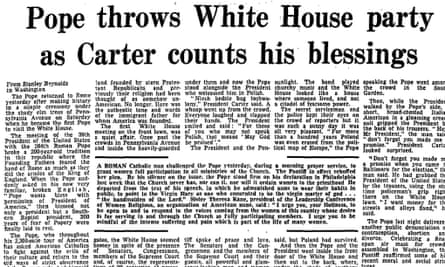
Other visits included a stopover in Fairbanks, Alaska in May 1984 , where he met President Ronald Reagan.
In 2008, Pope Benedict XVI visited Washington and New York. Making his first visit to the US since his election in 2005, he was greeted on the White House lawn by the president, George Bush, plus a 21-gun salute and a serenade from a world-class opera singer.
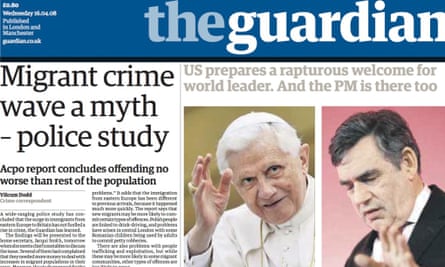
The 265th pope gave a resounding endorsement of the role of religion in democratic society telling a crowd of thousands that ‘the need for global solidarity is as urgent as ever’ in an age of extremism and terror. The following day he addressed the UN general assembly .
Visiting the US at the same time was Gordon Brown, the British prime minister, but, as Stephen Bates noted, he was never going to dominate the news agenda as ‘ passing popes will always outrank prime ministers .’

- Pope Francis
- From the Guardian archive
- Catholicism
- Christianity
Comments (…)
Most viewed.
The New York Times
New york | popes in america.
Advertisement
New York | Francis in America
Popes in america.
By EMILY S. RUEB SEPT. 18, 2015
When Pope Paul VI touched down in New York City on Oct. 4, 1965, he became the first pontiff to visit the Western Hemisphere. Pope John Paul II made seven trips to the United States over two decades. The last papal visit came in 2008, when Pope Benedict XVI stopped in New York and Washington.
All three popes filled stadiums and were feted like rock stars as their motorcades wended through city streets. But the pontiffs also used their time in the American spotlight to speak out on a range of issues, including human rights, nuclear arms and abortion.
Here is a look back at some of the highlights from papal visits past.
As the first pontiff to visit the United States, Pope Paul VI spent 13 and a half hours in New York. At the United Nations, he issued a stirring call for disarmament in the nuclear age. He quoted President John F. Kennedy, the country's first Roman Catholic president, who had died two years before, declaring that mankind must put an end to war or war would put an end to mankind.
"No more war, never again war!" he pleaded in English with a soft Italian accent. "Drop your weapons. One cannot love with offensive weapons in hand."
The room, which was filled with 2,000 dignitaries and special guests including several members of the Kennedy family, erupted in a standing ovation after his 35-minute address.

Earlier, he met with President Lyndon Johnson for 46 minutes at the Waldorf Astoria hotel. He also visited St. Patrick's Cathedral and a church near the United Nations.
Millions lined the city streets to greet the pope, including 18,000 police officers providing security. He made a 25-mile procession inside a bubble-top limousine that started in Queens, went through Harlem and eventually down Fifth Avenue in Manhattan.
' Pope Calls for 'No More War' as U.N. Goal and Urges Effort to Admit All Nations ," The New York Times, October 5, 1965
'Thousands Guard Paul on Trip ,' The New York Times, October 5, 1965
' Two Leaders Meet ,' The New York Times, October 5, 1965
Video of the Pope at St. Patrick's Cathedral , ABC News, October 4, 1965
In October 1979, Pope John Paul II made the first of seven visits to the United States, where he outlined a program for his papacy. Over the course of a week, he visited six cities and delivered 69 speeches and sermons.
"I greet you, America the beautiful!" he said to a crowd of 100,000 at Boston Common . The rain-soaked crowd responded with cries of "Viva Papa!"

From Boston, he went on to New York, where he spoke at the United Nations and urged world leaders to sustain the human rights of all people, including Palestinian Arabs. He also warned of the perils of the nuclear arms race and repeated the words that Pope Paul VI said 14 years before: “ No more war. War never again .”
His two days in the city ended with an evening Mass at Yankee Stadium , where he asked 80,000 congregants to remember the "urgent need" of service to the poor.
"Even New York City, with its love of parades, theatrical opening-nights and sports spectaculars, has seldom seen anything like this," wrote The Times.

After an hourlong private meeting, the 59-year-old pope and the president, a born-again Christian, addressed about 10,000 invited guests on the South Lawn. With the Senate considering the strategic arms limitation agreement, the pope issued a strong call for weapons restrictions .
"Mr. President, ladies and gentlemen, I know and appreciate this country's efforts for arms limitation, especially of nuclear weapons," he said. "With all my heart, I hope that there will be no relaxing its efforts."
Thousands gathered for worship on the Mall , the concluding event of his trip.
"Human life is precious because it is the gift of a God whose love is infinite," he said, reiterating his stance against abortion. "And when God gives life, it is forever."

' Text of Pope John Paul II's Homily at a Mass on Boston Common ,' The New York Times, Oct. 2, 1979
' Special Issue: The Pope in New York ,' The New York Times, Oct. 3, 1979
' Pope Firmly Defends Church Restriction on Contraception ,' The New York Times, Oct. 6, 1979
' 53 Nuns, After a Prayer, Stand in a Silent Protest to Pontiff Candidates for Priesthood Turns Away From Banners ,' The New York Times, Oct. 8, 1979
' New Challenge for U.S. Catholics ,' The New York Times, Oct. 9, 1979
When Pope John Paul II and President Ronald Reagan met while their airplanes refueled at Fairbanks International Airport in Alaska, it was the first time a president and a pope met somewhere other than the White House or Vatican, according to the United States Conference of Catholic Bishops. It was the second time the two met, and the first since the United States reestablished full diplomatic relations in January of that year, according to The Times.
It was the pope's second time in Alaska, where, under rainy gray skies, he was greeted by musical concerts and vendors selling Polish sausage sandwiches.
The pope made an appeal to the president and to 5,000 Alaskans for ''an openness of heart, a readiness to accept differences and an ability to listen to each other's viewpoint without prejudice.''
' Reagan and Pope Confer in Alaska on World Issues ,’ The New York Times, May 3, 1984
Pope John Paul II began a 10-day tour of the United States in Miami, where he was welcomed by a crowd that included President Ronald Reagan and the first lady. Under his administration, the United States established full diplomatic relations with the Holy See, which meant the pope was officially received as a head of state. Previously, he was merely extended the courtesies due his status.
His tour -- which included stops in Columbia, S.C.; New Orleans; San Antonio; Phoenix; San Francisco; Detroit; and Los Angeles, where he met with Clint Eastwood -- coincided with bicentennial celebrations of the Constitution.
"'I willingly join you in your prayer of thanksgiving to God for the providential way in which the Constitution has served the people of this nation for two centuries," he said.

Pope John Paul II's visit to San Francisco underscored the church's conservative attitudes on homosexuality and AIDS. There, he confronted a large group of protesters who shouted "Pope go home" and "Nazi Pope," and carried signs that read, "Curb your dogma."
Homosexuals ''are not outcasts'' in the church, said the pope, but instead, ''like all people who suffer, they are in the heart of the church.''
''God loves you all, without distinction, without limit,'' the pope said at the Mission Dolores Basilica. ''He loves those of you who are sick, those who are suffering from AIDS and from AIDS-related complex.''
There, the pope met with 100 Catholic AIDS patients, including two priests.
Asked about the causes of AIDS, he said, ''The church is doing all that is possible to heal and especially to prevent the moral background of this.''
His visit concluded in Detroit, where he delivered his strongest anti-abortion language of the trip .
"If you want equal justice for all, and true freedom and lasting peace, then, America, defend life from conception until natural death."
' Pontiff Embraces Welcome in Miami; Deflects Queries ,’ The New York Times, Oct. 3, 1987
' AIDS Issue at Fore as Pope Visits San Francisco Today ,' The New York Times, Sept. 17, 1987
' Pope Stresses Forgiveness As Homosexuals Protest ,' The New York Times, Sept. 18, 1987
Pope John Paul II joined 180,000 young Catholics from 70 countries in Denver at World Youth Day . During his trip, the pope lamented what he called "the false morality of modern society." He called abortion and euthanasia “the slaughter of innocents,” and urged young people to practice “natural” birth control.
He publicly acknowledged "the suffering and scandal" surrounding the sexual molestation of young people by Catholic priests.
After his first face-to-face encounter with President Bill Clinton, the pope spoke out strongly against the president’s stand on abortion, remarks that appeared to take the White House by surprise .

"In developed countries, a serious moral crisis is already affecting the lives of many young people, leaving them adrift, often without hope, and conditioned to look only for instant gratification," he said. "Only by instilling a high moral vision can a society insure that its young people are given the possibility to mature as free and intelligent human beings, endowed with a robust sense of responsibility to the common good, capable of working with others to create a community and a nation with a strong moral fiber."
' Pope Expounds Stern Guidelines, Warning U.S. Could Lose Its Soul, ' The New York Times, Aug. 15, 1993
' Pope Edits His Most Critical Language to End Visit on Positive Note, ' The New York Times, Aug. 16, 1993
On his fourth visit to the United States, Pope John Paul II returned to New York after a 16-year absence . President Bill Clinton and Hillary Rodham Clinton, the governors of New York and New Jersey, and 800 dignitaries, political leaders and almost the entire hierarchy of the Roman Catholic Church in this country greeted him. He ur ged peace, support for the United Nations, openness to immigrants and a continuation of American social programs for the poor.
"Ancient rivalries and suspicions still compromise the cause of peace. We must find ways to set them aside. If we do not, history and the Lord of history will judge us harshly."
In a nation of immigrants, he said, "it would indeed be sad if the United States were to turn away" from sharing its blessings with newcomers. And the poor and disadvantaged also have roles in "a society in which none are so poor that they have nothing to give and none are so rich that they have nothing to receive."

At Giants Stadium in the Meadowlands, before a wet but jubilant crowd of 83,000 people, he intensified his call to America to preserve its openness to immigrants and its social support of the poor.
"Today, as before, the United States is called to be a hospitable society, a welcoming culture. If America were to turn in on itself, would this not be the beginning of the end of what constitutes the very essence of the American experience?"
He recited the rosary with more than 3,000 invited guests at St. Patrick’s Cathedral. Outside, the pope broke from behind his bulletproof shields and security guards when he went on an unexpected stroll on the streets of New York .
The largest event and the centerpiece of his four-day visit was a Mass with 125,000 congregants on the rain-soaked playing fields of the 50-acre Great Lawn in Central Park.
In his homily, he exhorted the faithful, and young people in particular, to care for the poor, the hungry, the homeless and people with AIDS, and to spread religious ideals in a world moving toward the third Christian millennium, wrote The Times.
"Stand up for marriage and family life!" the pope said. "Stand up for purity." Clad in a gold-trimmed miter and vestments, he spoke from a majestic altar draped with papal flags of purple and gold and brilliantly illuminated with hundreds of spotlights.

Texts of Speeches at the Airport and Sacred Heart Cathedral , The New York Times, The New York Times, Oct. 5, 1995
' On Newark’s Highest Hill, Faith and Joe Overflow, ' The New York Times, The New York Times, Oct. 5, 1995
' Confront Crises, Pope Urges Nation, ' The New York Times, Oct. 6, 1995
A Homily Links Human Progress and Salvation (Remarks at Aqueduct Race Track in Queens, a Mass for 75,000), ' The New York Times, Oct. 7, 1995
125,000 Join Pope at Mass in Central Park ‘Basilica,’ The New York Times, Oct. 8, 1995
It was a potentially awkward moment when Pope John Paul II shook hands with President Bill Clinton at an airport in St. Louis, as the Monica Lewinsky scandal embroiled the country. The Vatican's main concern seemed to be that the moral vision laid out by the pope not be drowned out by the awkward iconography of the moment.
Later, at the Kiel Center in St. Louis, a cavernous indoor sports arena, he was greeted by about 20,000 teenagers waving yellow scarves, screaming and chanting "We love you," as well as the St. Louis Cardinal Mark McGwire, who is Catholic.
The ailing pope, whose voice was slurred as the result of Parkinson's disease, was at times difficult to understand. But his spirit seemed to be buoyed by the boisterous crowd. After being presented with a hockey stick, the pope rose from his armchair and briefly lowered his staff and used it to mime the motion of a hockey pass. The crowd approved with raucous laughter and applause.
The next day, the 78-year-old pope preached to 100,000 people at the Trans World Sports Dome, urging Roman Catholics to extend the crusade to protect human life and to include murderers on death row.
"The new evangelization calls for followers of Christ who are unconditionally pro-life," he said. "Modern society has the means of protecting itself, without definitively denying criminals the chance to reform."
' Pope Sets Forth a Moral Agenda in St. Louis Visit ,' The New York Times, January 27, 1999
‘ Pope, in St. Louis Mass, Urges U.S. Catholics to Oppose Death Penalty ,’ The New York Time, January 28, 1999
Before Pope Benedict XVI landed at Andrews Air Force Base to begin a six-day visit, he admitted to reporters he was “deeply ashamed ” of the Roman Catholic Church's sexual-abuse scandal in the United States.
“Who is guilty of pedophilia cannot be a priest,” he said.
Throughout his trip, he would reiterate this message.
While celebrating Mass at Nationals Park before nearly 50,000 people, his first major encounter with the country’s diverse church, he brought it up in his homily.
"No words of mine could describe the pain and harm inflicted by such abuse," he said. "It is important that those who have suffered be given loving pastoral attention."

On Benedict’s 81st birthday, he met with President George W. Bush at the White House.
In New York, Pope Benedict XVI became the first pope to visit a Jewish synagogue in the United States, when he offered Passover greetings to local Jewish clergy at the Park East Synagogue.
At the United Nations General Assembly, Benedict emphasized the protection of human rights as "the most effective strategy for eliminating inequalities between countries and social groups, and for increasing security."
He also celebrated Mass at St. Patrick’s Cathedral and Yankee Stadium and blessed the site of the Sept. 11, 2001 terrorist attacks on the World Trade Center, pleading with God to bring "peace to our violent world."

' Text of Pope's Speech to Bishops ,' The New York Times, April 17, 2008
' Benedict Meets With the Victims of Sexual Abuse ,' The New York Times, April 18, 2008
' Slide Show: Papal Mass in Washington ,' The New York Times, April 17, 2008
' Slide Show: The Pope's Visit to New York ,' The New York Times, April 18, 2008
' Pope Benedict XVI’s Address to the U.N. General Assembly ,' The New York Times, April 19, 2008

Pope Francis’ Visit to U.S.

Full Coverage on Pope Francis’ Visit to U.S.

Pope Francis’ Visit to U.S. Is His First Ever, for Several Reasons

Pope Francis, on U.S. Visit, Will Reach Out to the Struggling

7 Lives Intersecting With Pope Francis’

Pope’s Visit Poses a Security Test for New York

Before the Pope’s Visit, a 180-Foot-Tall Francis Arrives in Midtown
Watch CBS News
The last time the Pope came to the U.S.
By Mark Knoller
September 21, 2015 / 9:36 PM EDT / CBS News

WASHINGTON - More than seven years have passed since the last visit to the U.S. by a pope.
In that same period of time British prime ministers have made 12 visits, German chancellors have come through the U.S. eight times, and Russian presidents, seven times.
- Pope Francis - CBS News
- Pope's visit inspires pledges of kindness in the U.S.
- In Cuba, pope celebrates his decision to become a priest
No other world leader gets the treatment accorded the pope on a visit to the U.S. That will be apparent as President Obama leads the nation in welcoming Pope Francis here Tuesday. It will be reminiscent of then- President George W. Bush's reception of then-Pope Benedict in 2008 .
To refresh my memory and yours, here are the notes from my daily log of presidential activity of Pope Benedict's reception in mid-April 2008.
Editor's note: The text below has only been lightly edited for clarity.
Tuesday, April 15, 2008
At 3:20pm, Pres. Bush departs via motorcade from the North Portico en route:
ANDREWS AFB, MD : The president arrives about 4:20pm and proceeds to holding in the VIP Lounge in the terminal. "Shepherd One," the Alitalia Boeing 777 carrying the Pope, lands about 3:50pm. It takes several minutes for the plane to taxi, for the stairs to be raised, for subordinates to disembark and for the red carpet to be unrolled.
Pres. and Mrs. Bush and daughter Jenna walk to the steps and are there to welcome the Pope as he sets foot on U.S. soil - to the cheers of some 400 well-wishers in special grandstands erected on the tarmac.
Bush and the Pope shake hands, but the pontiff does not kneel to kiss the ground as his predecessor was inclined to do.
Bush escorts the Pontiff to the VIP Lounge for about 15 minutes of private talks. Then they emerge and the Bushes escort the Pope to his limousine - one from the Secret Service fleet. He departs.
Bush heads to his motorcade on the other side of the Andrews Air Force Base passenger terminal and heads back to D.C. His motorcade creates some traffic jams - on the Beltway, Suitland Parkway, I-295 and the Southwest Freeway. He arrives back at the White House about 450p.
Wednesday, April 16
It's Pope Benedict XVI day at the White House. More than 13,500 people are on the South Lawn, believed to be a record-size crowd, to watch the ceremony welcoming the Pope to the White House. It's only the 2nd time a Pope has been at the White House.
He arrives in a limousine from the Presidential fleet at 1030a and is accorded full diplomatic and military honors as a Chief of State - including a 21-gun salute.
The Old Guard Fife and Drum Corps performs its Yankee Doodle routine.
The crowd is excited and enthusiastic about the Pope's presence - especially on this - his 81st birthday. The crowd spontaneously erupts in the singing of "Happy Birthday." The president mentions the Pope's birthday and as the ceremony ends soprano Kathleen Battle sings "Happy Birthday" to the Pope.
Inside the White House, Pastry Chef Bill Yosses rolls out a three foot high birthday cake for the Pope. Happily for the 81-year-old pontiff, there's only one lit candle on top for him to blow out.
The President and Pontiff then proceed to the Oval Office for about 40 minutes of private talks. They issue a joint statement afterwards, saying they discussed Iraq and concerns about "the precarious state of Christian communities there."
Their written joint statement also made an apparent reference to Papal concerns about interrogation techniques. It said the leaders "touched on the need to confront terrorism with appropriate means that respect the human person and his or her rights."
About 11:55am, the Pope departs the White House - in his white Mercedes-Benz Popemobile - leaving by way of the southeast gate, north on East Executive and then west on Pennsylvania Avenue, which had been cleared of traffic to Rock Creek Park and then outbound on Massachusetts Avenue to the Vatican Embassy.
At 245pm, Bush appears in the Rose Garden to deliver an 18-minute speech setting out his latest approach to climate change. He announces setting a national goal of stopping the growth of greenhouse gas emissions by the year 2025.
He makes the announcement today because the U.S. takes part tomorrow in another global conference on Climate Change in Paris.
In the evening, the President staged a dinner in honor of Pope Benedict - but the Pontiff did not attend because of prior religious commitments to cardinals and bishops.
- White House
- George W. Bush
- Barack Obama
- Catholic Church

Mark Knoller is a CBS News White House correspondent.
More from CBS News
50 Years Of Pope Visits To The United States

Reporter, HuffPost
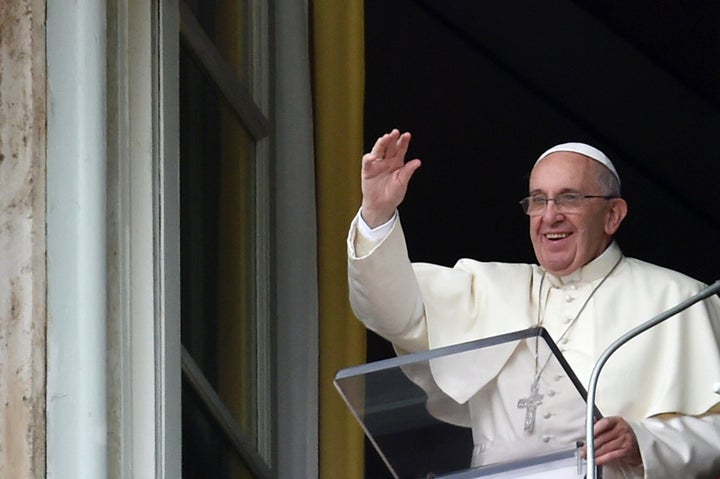
Pope Francis waves to faithfuls gathered in St. Peter's Square following his Sunday Angelus prayer from the window of the pontiff studio on August 16, 2015 at the Vatican.
Pope Francis will make his first visit to the United States in September, with stops in Washington, New York and Philadelphia. His trip will add to the 50-year history of pope visits to the U.S.
Pope Paul VI made the first papal visit to the U.S. in October 1965. He addressed the United Nations General Assembly, attended the New York World's Fair and celebrated Mass at Yankee Stadium. He also met with President Lyndon Johnson.
In October 1979, Pope John Paul II made his first of seven trips to the U.S. He visited Boston, New York, Philadelphia, Chicago and Des Moines, and met President Jimmy Carter in Washington.
In February 1981, John Paul II spent several hours on a stopover in Anchorage, Alaska, after canonizing the first Filipino saint, Lorenzo Ruiz , in Manila. Three years later, he met President Ronald Reagan during another stopover in Alaska, while en route to canonize 103 martyrs in Seoul, South Korea.
John Paul II's longest U.S. visit was in September 1987, when he made stops in Miami; New Orleans; San Antonio, Texas; Phoenix; Los Angeles; Salinas, California; and Pontiac, Michigan. In 1993, he celebrated Mass at World Youth Day and met with President Bill Clinton in Denver.
John Paul II visited New York City, New Jersey and Baltimore in 1995, and met again with Clinton. His final visit was in January 1999, when he celebrated Mass with more than 100,000 people at a football dome in St. Louis.
Pope Benedict XVI visited the U.S. once, in April 2008. He met with President George W. Bush at the White House and visited New York City, where he offered a blessing at the World Trade Center site.
Here's a look back at 50 years of pope visits to the U.S.:
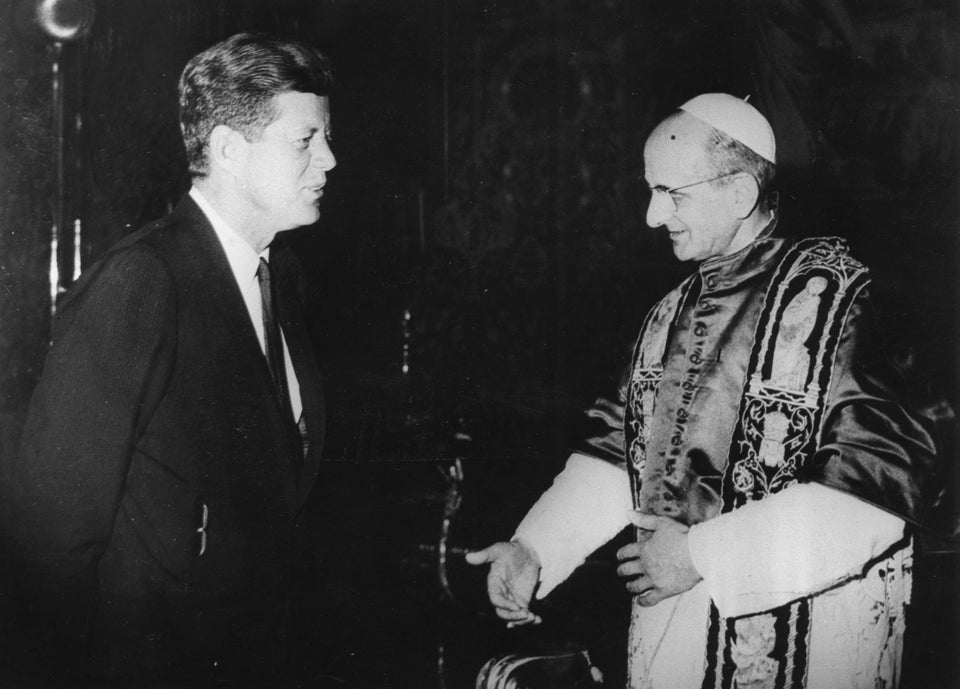
Pope John Paul II gestures to the crowd during his trip to the United States, on Oct. 6, 1979.
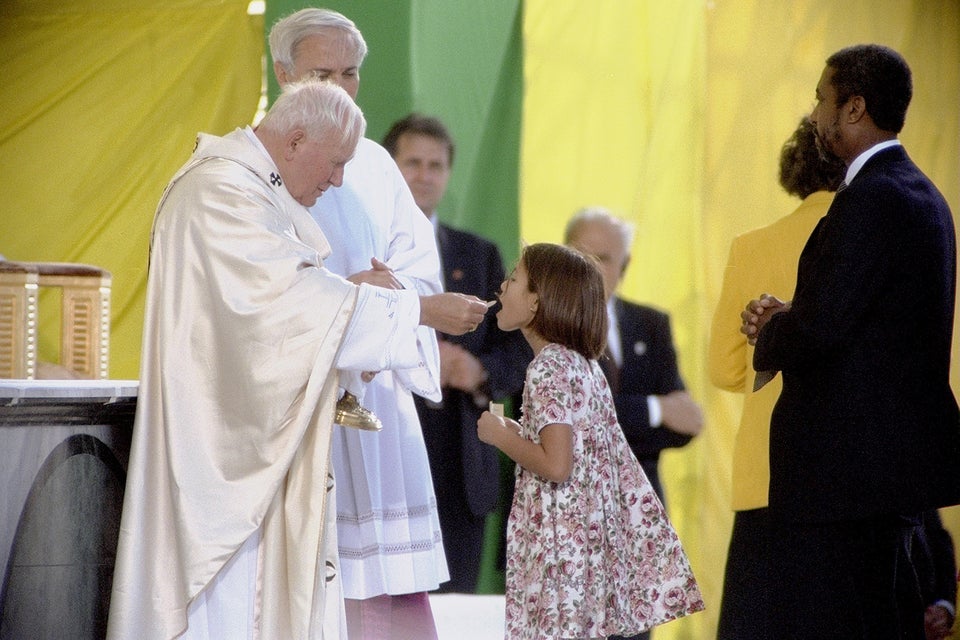
Young girl receives communion from Pope John Paul II as they celebrate Mass at Aqeduct Race Track in Jamaica, Queens, on Oct. 6, 1995.
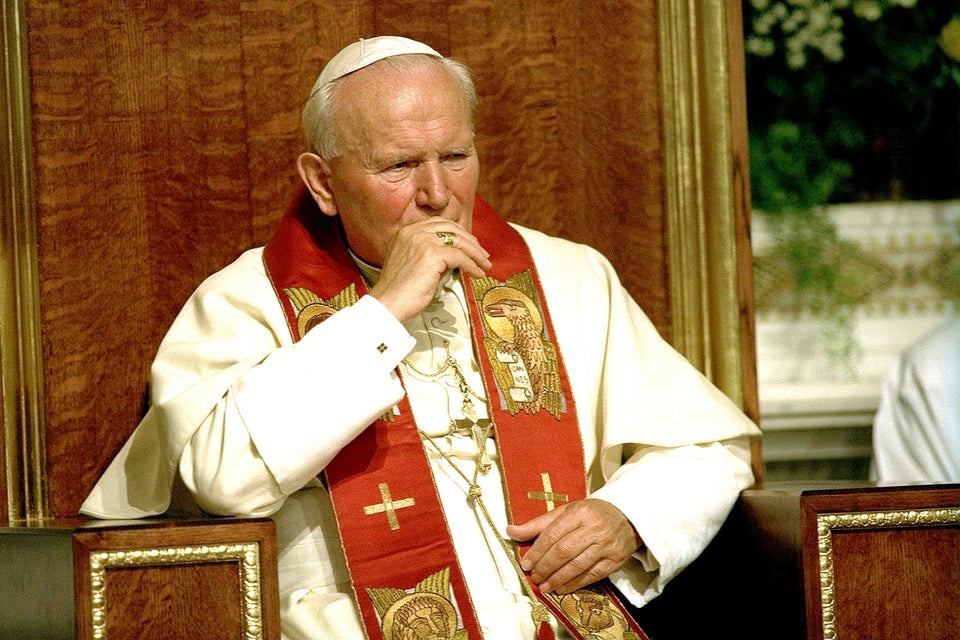
Pope John Paul II says evening prayers in the Chapel of St. Peter and St. Paul at St. Joseph's Seminary in Yonkers, during his 1995 visit to the U.S.
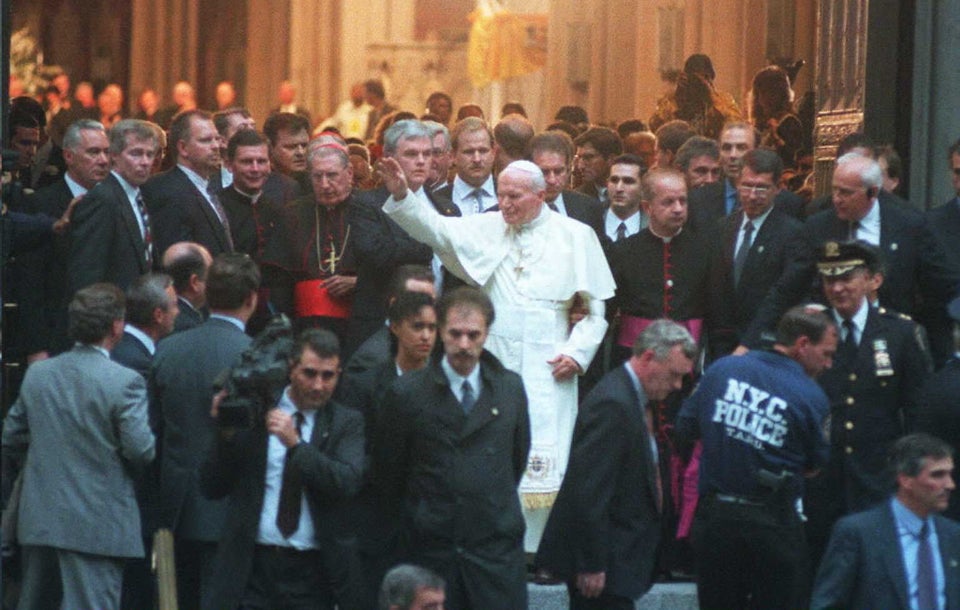
Pope John Paul II leaves St. Patrick's Cathedral on Oct. 7, 1995, in New York surrounded by security and police as he heads for an impromptu walk down Fifth Avenue.

Pope John Paul II prepares communion during an outdoor Mass in New York's Central Park, Oct., 7, 1995.
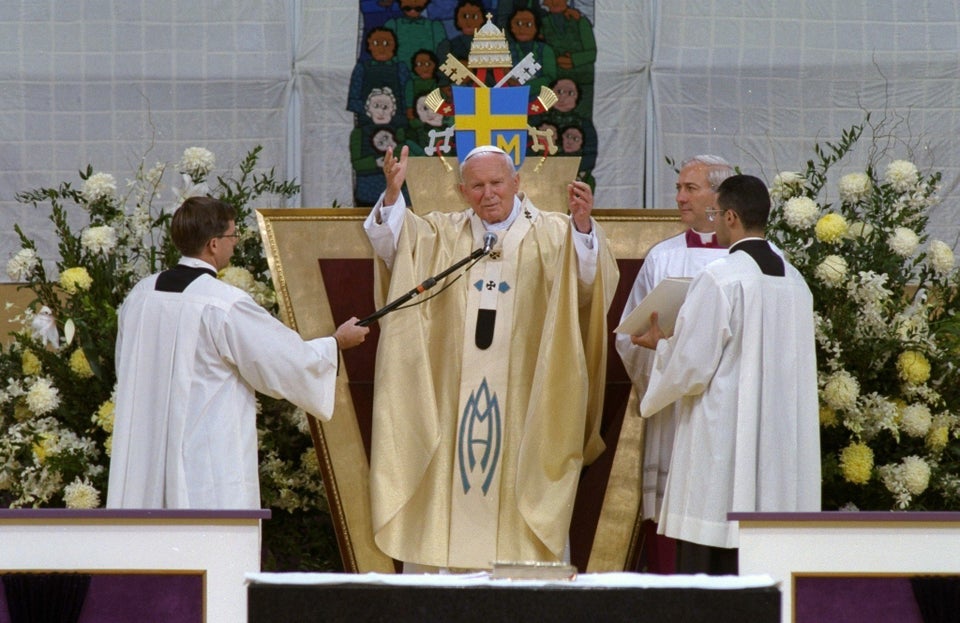
Pope John Paul II during Mass in Central Park on Oct. 8, 1995.
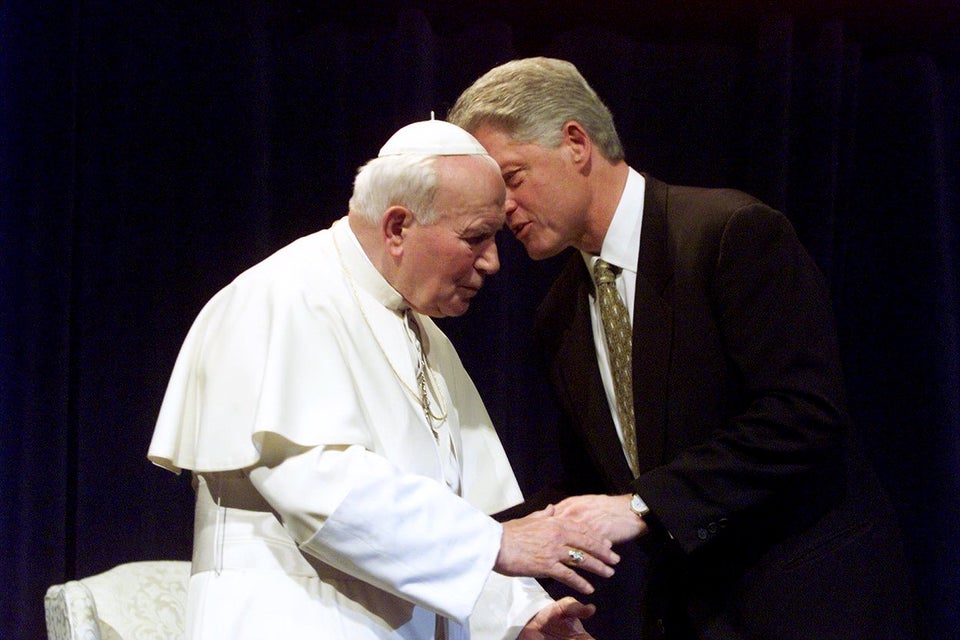
Pope John Paul II greets President Bill Clinton during his visit to St. Louis in 1999.
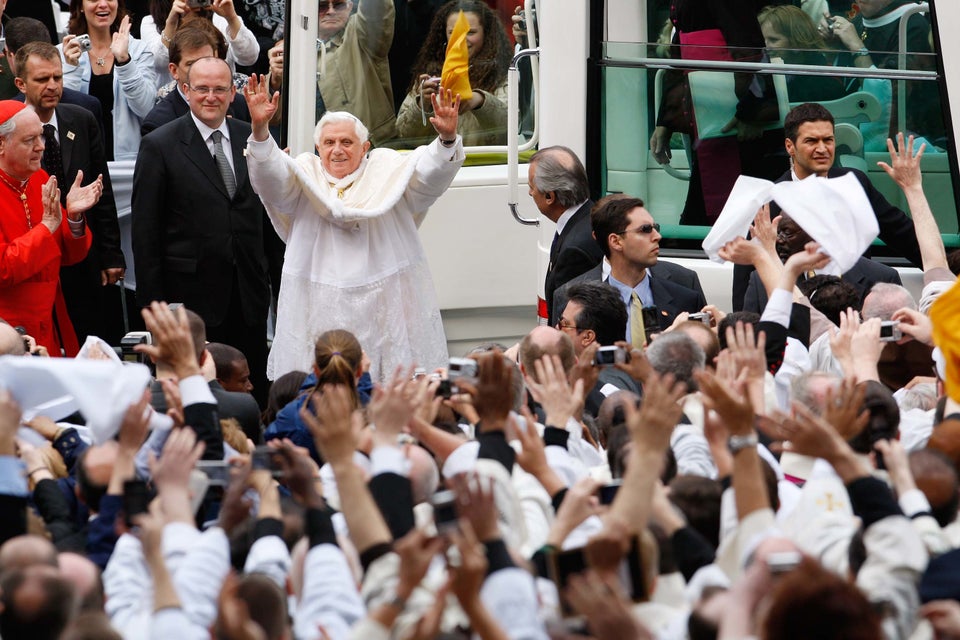
Pope Benedict XVI waves to supporters after exiting the popemobile at Yankee Stadium in the Bronx borough of New York, U.S., on Sunday, April 20, 2008.

Pope Benedict XVI gestures as he arrived for a mass at the Yankee Stadium in New York on April 20, 2008.
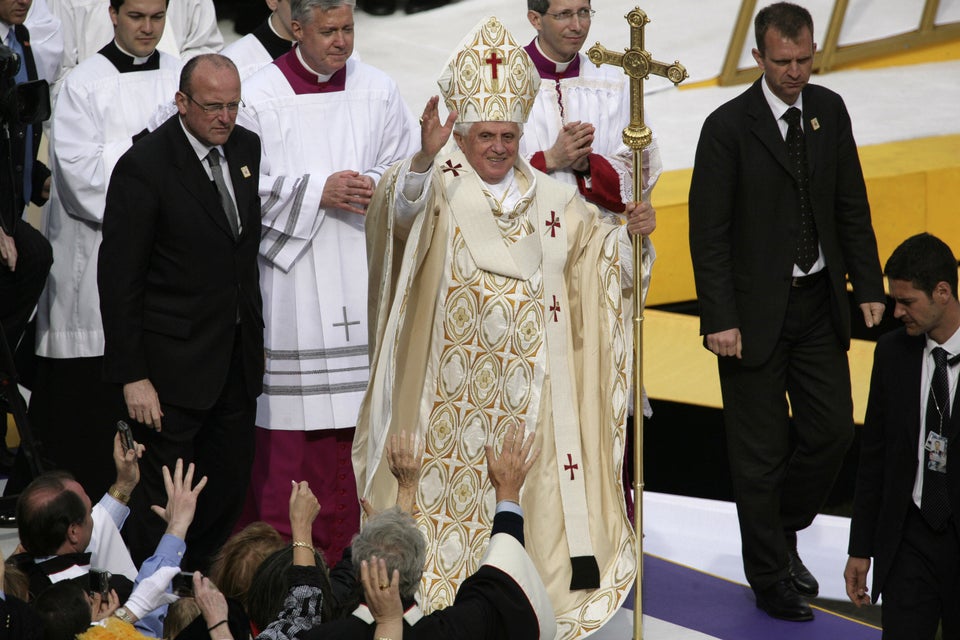
Pope Benedict XVI waves after the conclusion of Mass at Yankee Stadium in New York on April 20, 2008.
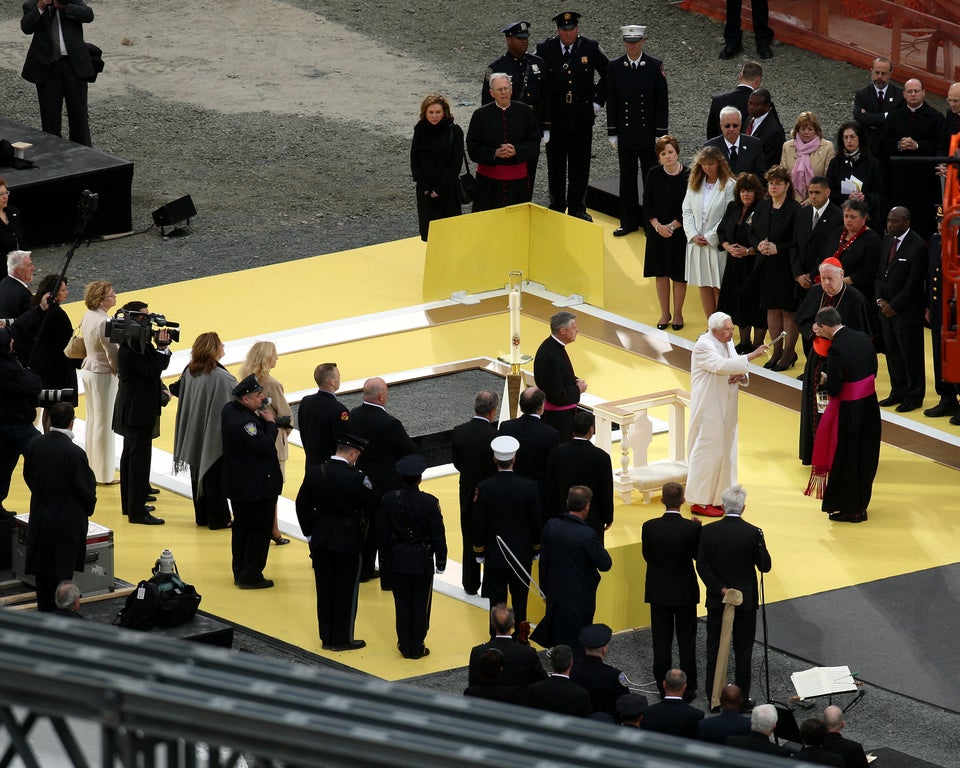
Pope Benedict XVI gives a blessing with holy water during ceremonies at Ground Zero on his last day in New York on April 20, 2008.
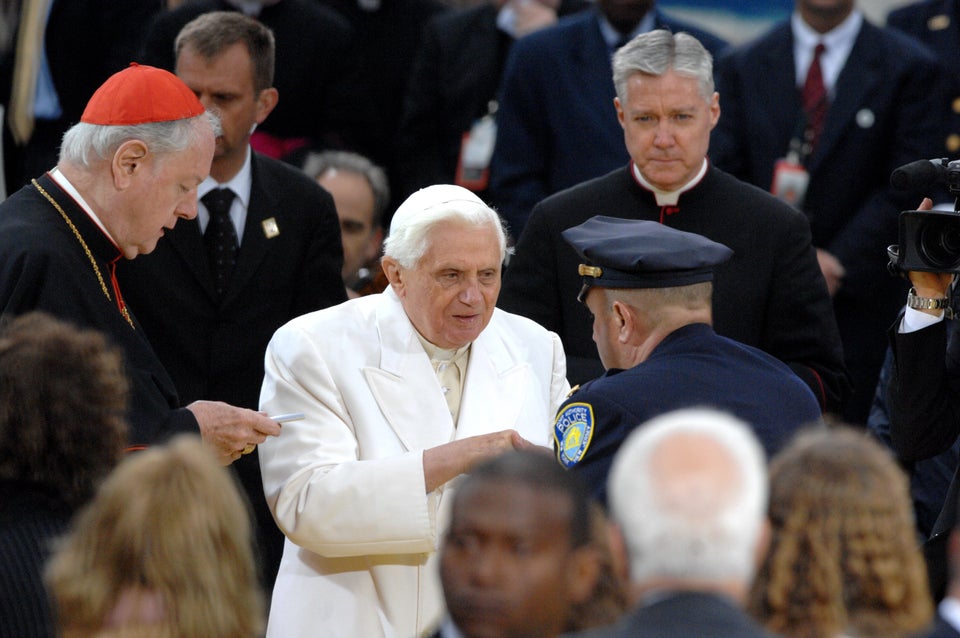
Pope Benedict XVI visits Ground Zero on his final day in New York City, April 20, 2008.
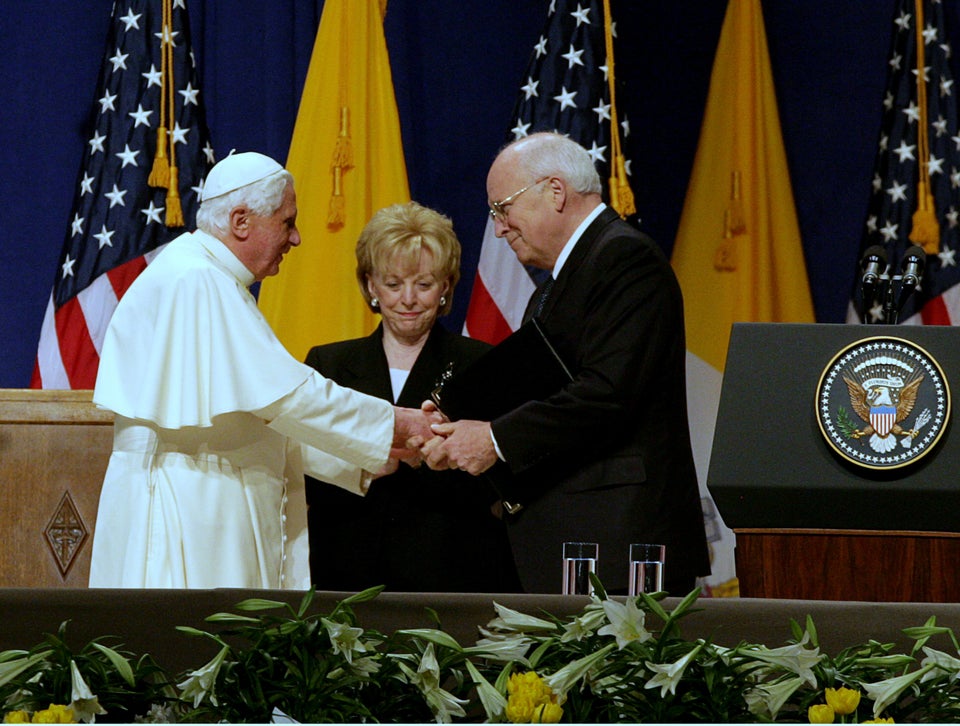
Pope Benedict XVI speaks at JFK International Airport, joined by Vice President Richard and Mrs. Lynne Cheney during his farewell ceremony on April 21, 2008.
Also on HuffPost:
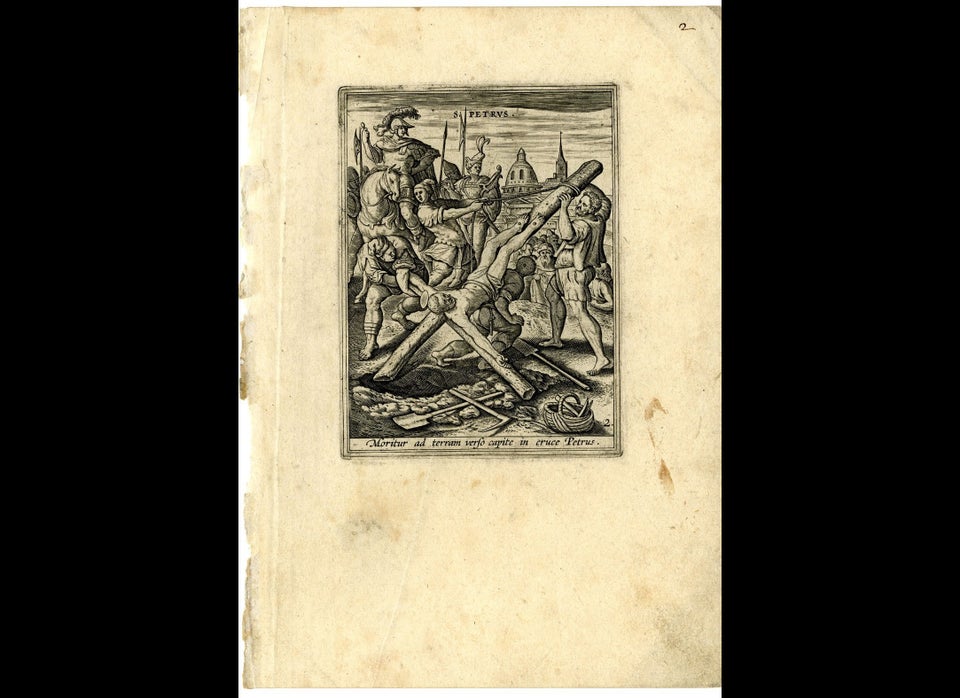
Popes Who Shook The World
Support huffpost, our 2024 coverage needs you, your loyalty means the world to us.
At HuffPost, we believe that everyone needs high-quality journalism, but we understand that not everyone can afford to pay for expensive news subscriptions. That is why we are committed to providing deeply reported, carefully fact-checked news that is freely accessible to everyone.
Whether you come to HuffPost for updates on the 2024 presidential race, hard-hitting investigations into critical issues facing our country today, or trending stories that make you laugh, we appreciate you. The truth is, news costs money to produce, and we are proud that we have never put our stories behind an expensive paywall.
Would you join us to help keep our stories free for all? Your contribution of as little as $2 will go a long way.
Can't afford to donate? Support HuffPost by creating a free account and log in while you read.
As Americans head to the polls in 2024, the very future of our country is at stake. At HuffPost, we believe that a free press is critical to creating well-informed voters. That's why our journalism is free for everyone, even though other newsrooms retreat behind expensive paywalls.
Our journalists will continue to cover the twists and turns during this historic presidential election. With your help, we'll bring you hard-hitting investigations, well-researched analysis and timely takes you can't find elsewhere. Reporting in this current political climate is a responsibility we do not take lightly, and we thank you for your support.
Contribute as little as $2 to keep our news free for all.
Dear HuffPost Reader
Thank you for your past contribution to HuffPost. We are sincerely grateful for readers like you who help us ensure that we can keep our journalism free for everyone.
The stakes are high this year, and our 2024 coverage could use continued support. Would you consider becoming a regular HuffPost contributor?
The stakes are high this year, and our 2024 coverage could use continued support. If circumstances have changed since you last contributed, we hope you’ll consider contributing to HuffPost once more.
Already contributed? Log in to hide these messages.
Popular in the Community
From our partner, more in religion.
Pope Francis on his relationship with Benedict: 'He always defended me'
Pope Francis discussed his relationship with his predecessor and called supposed tensions between their supporters "nonsense" in an upcoming book-length interview.
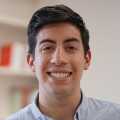
Pope Francis chats with retired Pope Benedict XVI at the retired pope's home in the Mater Ecclesiae monastery at the Vatican June 30, 2015. (CNS photo/L'Osservatore Romano)
VATICAN CITY (CNS) -- For the nearly 10 year s that Pope Francis and retired Pope Benedict XVI lived on opposite sides of St. Peter's Basili ca, th e two popes' relationship was marked by a deep mutual respect and profound sense of solidarity, Pope Francis said.
The retired pope, he said, would even defend Pope Francis before his critics.
In a book-length interview, "El Sucesor" ("The Succ ess or"), scheduled for publication i n Spain April 3, Pope Francis recalled the support he received from his predecessor in specific incidents and throughout his pontificate.
Speaking with Spanish journalist Javier Martínez-Brocal, the pope pointed to the time he spoke favorably about French civil union laws during an airborne press conference returning to Rome from Slovakia. laws. A group of cardinals went to the Vatican monastery where Pope Benedict lived and, he said , "practically put me on trial, and in front of him they accused me of promoting homosexual marriage."
"B enedict was not shaken, because he knew perfectly well what I think," Pope Francis said. "He listened to them, one by one, calmed them down and explained everything."
In three separate interview sessions with Martínez-Brocal for the book, Pope Francis repeated several times that Pope Benedict never said he disagreed with him, but that the retired pope would sometimes encourage him to seek out more information or consider other points of view.
"He never took his support away from me. Maybe there was something I did that he did not agree with, but he never said so," Pope Francis recalled.
The po pe tr aced Pope Benedict's support for him back to when he was archbishop of Buenos Aires. He said that as he was approaching 75 -- the age at which all Catholic bishops must offer their resignation to the pope -- a group of Vatican officials in the Dicastery for Bishops "had assembled a story so that the pope would accept my resignation as archbishop of Buenos Aires" and already had a replacement for him lined up.
"I don't know why Cardinal Bergoglio has so many enemies here," Pope Francis recalled his predecessor saying in a conversation with Cardinal Marc Ouellet, then-prefect of the dicastery, before deciding to postpone his resignation for two years. Cardinal Bergoglio wa s el ected pope less than 15 months after his 75th birthday.
However, Pope Francis did not shy away from discussing tensions with Pope Benedict's aides. Praising Pope Benedict's meekness -- which he insisted was not a weakness -- Pope Francis said some people close to Pope Benedict took advantage of his kind nature, "limited his actions" and gradually "fenced him off."
He said he asked Pope Benedict's secretary, Archbishop Georg Gänswein, to take a voluntary leave following controversy surrounding the 2020 publication of a book supposedly co-authored by the retired pope and Cardinal Robert Sarah, then-prefect of the Congregation for Divine Worship and the Discipline of the Sacraments.
The book, "From the Depths of Our Hearts: Priesthood, Celibacy and the Crisis of the Catholic Church," argued against changing the discipline of celibacy for Latin-rite Catholic priests and was published as Pope Francis prepared his apostolic exhortation on the Synod of Bishops on the Amazon. Bishops at the synod had discussed the possibility of ordaining some married men, a suggestion Pope Francis did not accept. But the book -- displaying side-by-side portraits of Pope Benedict and Cardinal Sarah on its cover-- was widely interpreted as a rare public interjection from the retired pope to exert pressure on Pope Francis.
Archbishop Gänswein later said Pope Benedict willingly contributed to the book but did not approve being credited as a co-author, chalking up the incident to a "misunderstanding."
The pope also said he was "pained" by the publication of Archbishop Gänswein's book about his experiences with Pope Benedict on the day of the late pope's funeral. The timing of the publication showed a "lack of nobility and humanity."
Pope Francis called the supposed tensions between his supporters and supporters of Pope Benedict "nonsens e," ad ding that some people in the church us e Pope Benedict to attack him only when they don't have real arguments to make against him, and that such people even "attribute things to Benedict that are not true."
"If there was a man than went forward, that was progressive, it was him," the pope said referring to his predecessor, noting how then-Father Joseph Ratzinger was "viewed with skepticism" during the Second Vatican Council for his advanced views. "Also, the decision to resign was very forward-thinking, very progressive."
While he noted that all popes are in some way misunderstood, Pope Francis said that "in the case of Benedict, (people) did not understand that interior freedom that he had."
After being elected to succeed Pope Benedict in 2013, he said he never felt pressure from the retired pope, although they sometimes discussed issues together . The German Synodal Path was of concern to Pope Benedict, he said, and they discussed the letter Pope Francis sent to German Catholics in 2019. However, he said, they did not discuss Pope Francis' 2021 apostolic letter "Traditionis Custodes " (Guardians of the Tradition) restricting the celebration of the pre-Vatican II Mass which Pope Benedict had expanded.
Pope Benedict died Dec. 31, 2022. Pope Francis said that while he was not involved in planning Pope Benedict's funeral, he said he has already made changes to simplify the papal funeral rites to bury popes "like any son of the church." Among the changes, he said, popes will have a single wake during which the body will already be in a casket rather than lying on a catafalque for public viewing.
While Pope Francis said Pope Benedict fits the bill for being proclaimed a doctor of the church -- a saint whose writings have had a particularly notable influence on Catholic theology or spirituality -- he said the naming of new doctors of the church is on hold since so many religious congregations request that their founders receive the title.
CATHOLIC NEWS SERVICE
With its Rome bureau founded in 1950, Catholic News Service has been providing complete, in-depth coverage of the popes and the Vatican for more than 70 years. CNS Rome continues to be your fair, faithful and informed connection to the Holy See.
Featured Stories
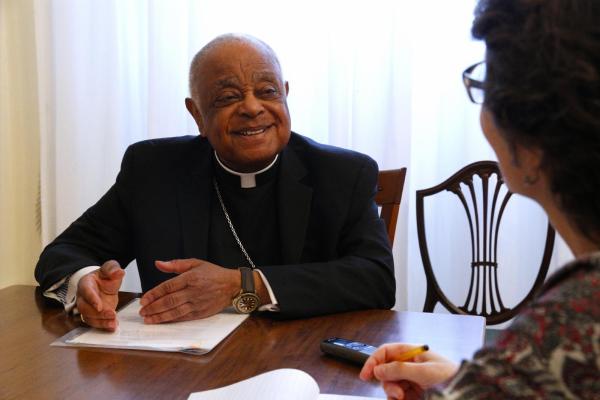
Parish priests are lifeline to church's mission, cardinal says
Cardinal Wilton D. Gregory of Washington was in Rome to receive the Rector's Award at the Pontifical North American College April 11. He sat down with Catholic News...
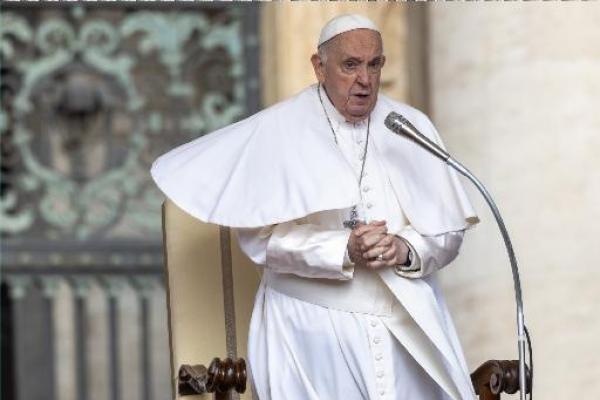
Pope Francis
Take evil seriously, pope says at general audience.
In his series of talks about virtues, Pope Francis today looked at "fortitude" and how it is needed today.
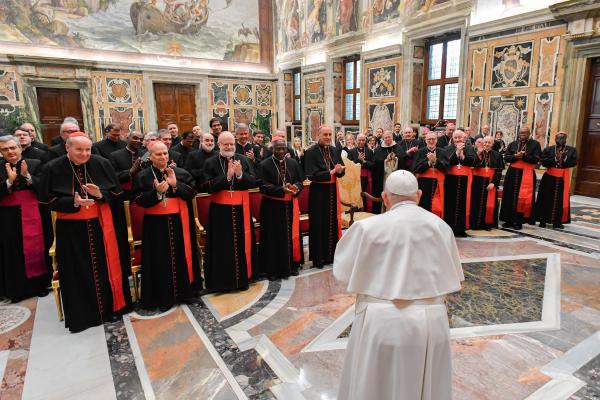
Vatican calls for proactive defense of human dignity in digital realm
A declaration published by the Vatican includes a section on how "digital violence" threatens human dignity.
Papal title ‘Patriarch of the West,’ dropped by Pope Benedict, reappears in 2024 Vatican yearbook

VATICAN CITY (CNS) -- The 2024 edition of the Vatican yearbook has inserted “Patriarch of the West” as one of the historical titles of the pope.
In 2006, Pope Benedict XVI dropped “Patriarch of the West” from his official titles listed in the Annuario Pontificio, the Vatican yearbook. Vatican officials at the time said the title was removed because it was theologically imprecise and historically obsolete.
In 2019, Pope Francis had all the remaining titles, except for “Bishop of Rome,” moved to another page, and in the 2020 edition of the Annuario they were listed as “historic titles.”
The titles labeled historic were: “Vicar of Jesus Christ. Successor of the Prince of the Apostles. Supreme Pontiff of the Universal Church. Primate of Italy. Archbishop and Metropolitan of the Province of Rome. Sovereign of Vatican City State. Servant of the Servants of God.”
The 2024 Annuario, which went on sale in early April, inserted “Patriarch of the West” after “Supreme Pontiff of the Universal Church.”
As of April 11, the Vatican press office said it had no explanation for the change.
Last year Cardinal Raniero Cantalamessa, preacher of the papal household, told officials of the Roman Curia that he noted “with joy” that only one title is listed under the pope’s name: Bishop of Rome.
“It seems right to me, especially with regard to ‘Vicar of Jesus Christ,’” the cardinal said. “Vicar is one who takes the place of the boss in his absence, but Jesus Christ never made himself absent and will never be absent from his church.”
When Pope Francis had the titles re-labeled, Matteo Bruni, director of the Vatican press office, told Catholic News Service that unlike in 2006 when Pope Benedict XVI had the title “Patriarch of the West” removed from the list, this time “there has been no suppression” of a title.
“The definition of ‘historic’ in relation to the titles attributed to the pope on one of the pages dedicated to him in the Annuario Pontificio of 2020 seems to me to indicate the bond with the history of the papacy,” Bruni said. All of the other titles “are understood to be tied historically to the title of bishop of Rome because at the moment he is designated by the conclave to guide the church of Rome, the one elected acquires the titles tied to this nomination.”
Before Pope Benedict dropped “Patriarch of the West,” the last time the list of titles was changed was with St. Paul VI’s 1969 edition of the Annuario, which added the title “servant of the servants of God” and deleted the phrase “gloriously reigning.”
Pope Francis’ first words to the public after his election March 13, 2013, were: “Brothers and sisters, good evening. You all know that the duty of the conclave was to give a bishop to Rome. It seems that my brother cardinals have gone almost to the ends of the earth to get him ... but here we are.”
The pope has said in interviews that he has not considered resigning, but if he ever did, he would be known as the “bishop of Rome emeritus” and not “pope emeritus” as Pope Benedict was.
When Pope Benedict dropped the title “Patriarch of the West,” the then-Pontifical Council for Promoting Christian Unity issued a statement, which said, “The title “Patriarch of the West” was adopted in the year 642 by Pope Theodore. Thereafter it appeared only occasionally and did not have a clear meaning. It flourished in the 16th and 17th centuries in the context of a general increase in the pope’s titles and appeared for the first time in the Annuario Pontificio in 1863.
While patriarchates have always been tied to a specific location and jurisdiction over it, “the term West currently refers to a cultural context not limited only to Western Europe but including North America, Australia and New Zealand, thus differentiating itself from other cultural contexts,” the pontifical council said. “If we wished to give the term West a meaning applicable to ecclesiastical juridical language, it could be understood only in reference to the Latin Church. In this way, the title ‘Patriarch of the West’ would describe the bishop of Rome’s special relationship with the Latin Church and could express the special jurisdiction he has over her.”
Members of the synod of bishops of the Ecumenical Orthodox Patriarchate of Constantinople expressed concern over the decision, however. In a June 2006 statement, the chief secretary of the synod said dropping “Patriarch of the West” while retaining the titles “Vicar of Jesus Christ” and “Supreme Pontiff of the Universal Church” is “perceived as implying a universal jurisdiction of the bishop of Rome over the entire church, which is something the Orthodox have never accepted.”
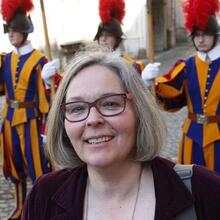
Most popular

Your source for jobs, books, retreats, and much more.
The latest from america
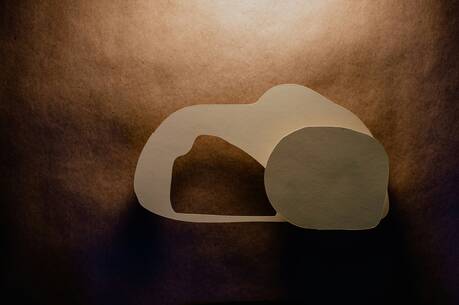
- Election 2024
- Entertainment
- Newsletters
- Photography
- Personal Finance
- AP Investigations
- AP Buyline Personal Finance
- Press Releases
- Israel-Hamas War
- Russia-Ukraine War
- Global elections
- Asia Pacific
- Latin America
- Middle East
- Election Results
- Delegate Tracker
- AP & Elections
- March Madness
- AP Top 25 Poll
- Movie reviews
- Book reviews
- Personal finance
- Financial Markets
- Business Highlights
- Financial wellness
- Artificial Intelligence
- Social Media
Pope exposes confidential details of past conclaves and settles scores with Pope Benedict XVI’s aide
FILE - Pope Francis, left, and Pope Benedict XVI, meet each other on the occasion of the elevation of five new cardinals at the Vatican, on June 28, 2017. Pope Francis has exposed the political “maneuvers” to sway votes during the past two conclaves and denied he is planning to reform the process to elect a pope in a new book-length interview published Tuesday April 2, 2024. (L’Osservatore Romano/Pool photo via AP, File)
FILE - Pope Francis talks with Papal Household Archbishop Georg Gaenswein during his weekly general audience, in the Paul VI Hall at the Vatican on Jan. 15, 2020. Pope Francis has exposed the political “maneuvers” to sway votes during the past two conclaves and denied he is planning to reform the process to elect a pope in a new book-length interview published Tuesday April 2, 2024. (AP Photo/Alessandra Tarantino, file )
FILE - Pope Francis, right, hugs Emeritus Pope Benedict XVI prior to the start of a meeting with elderly faithful in St. Peter’s Square at the Vatican on Sept. 28, 2014. Pope Francis has exposed the political “maneuvers” to sway votes during the past two conclaves and denied he is planning to reform the process to elect a pope in a new book-length interview published Tuesday April 2, 2024. (AP Photo/Gregorio Borgia, File)
FILE - Pope Emeritus Benedict XVI, center, is helped to walk down the steps by Bishops Vincenzo Paglia, left, and Georg Gaenswein prior to the start of a meeting of Pope Francis with the elderly in St. Peter’s Square at the Vatican, on Sept. 28, 2014. Pope Francis has exposed the political “maneuvers” to sway votes during the past two conclaves and denied he is planning to reform the process to elect a pope in a new book-length interview published Tuesday April 2, 2024. (AP Photo/Gregorio Borgia, File)
FILE - Pope Francis salutes Pope Emeritus Benedict XVI, left, at the end of a consistory in the St. Peter’s Basilica at the Vatican, on Feb. 22, 2014. Pope Francis has exposed the political “maneuvers” to sway votes during the past two conclaves and denied he is planning to reform the process to elect a pope in a new book-length interview published Tuesday April 2, 2024. (AP Photo/Alessandra Tarantino, File)
- Copy Link copied
VATICAN CITY (AP) — Pope Francis has exposed the political “maneuvers” used to sway votes during the two most recent elections of popes, while denying he is planning to reform the process for future conclaves, in a book-length interview published Tuesday.
The confidential revelations are contained in “The Successor: My Memories of Benedict XVI ,” in which the Argentine pope reflects on his relationship with the late German pope and settles some scores with Benedict’s longtime aide.
The book, written as a conversation with the correspondent for Spain’s ABC daily, Javier Martínez-Brocal, comes at a delicate time for the 87-year-old Francis. His frail health has raised questions about how much longer he will remain pope, whether he might follow in Benedict’s footsteps and resign, and who might eventually replace him.
In the book, Francis revealed previously confidential details about the 2005 conclave that elected Benedict pope and the 2013 ballot in which he himself was elected, saying he was allowed to deviate from the cardinals’ oath of secrecy because he is pope.
In 2005, Francis said, he was “used” by cardinals who wanted to block the election of Benedict — then Cardinal Joseph Ratzinger — and that they managed to sway 40 out of 115 votes his way. The idea wasn’t to elect the Argentine but rather to force a compromise candidate after knocking Ratzinger out of the running, he said.
“They told me afterward that they didn’t want a ‘foreign’ pope,” — in other words, a non-Italian one — Francis said, making clear that the process wasn’t so much about the Holy Spirit inspiring cardinals as it was a cold, hard political calculus.
Francis said he put an end to the maneuvering by announcing that he wouldn’t accept being pope, after which Ratzinger was elected.
“He was the only one who could be pope in that moment,” Francis said, adding that he, too, voted for Ratzinger.
In 2013, after Benedict’s resignation, there was also political maneuvering involved . Francis — who at the time was Cardinal Jorge Mario Bergoglio — said he only realized after the fact that cardinals were coalescing behind him, pestering him with questions about the church in Latin America and dropping hints that he was gaining support.
He said it finally dawned on him that he might be pope when Spanish Cardinal Santos Abril y Castelló came running after him after lunch on March 13, just before what would become the final ballot.
The Spanish cardinal had what was clearly a health-related question about Bergoglio’s ability to take on the physical rigors of the papacy, after opponents apparently had raised his health as a possible impediment to his election.
“Eminence, is it true you’re missing a lung?” Francis recounted Abril as saying, to which he replied that he had part of one lung removed after a respiratory infection. After he assured the cardinal that the operation had taken place more than 50 years earlier, he remembered Abril muttering: “Oh these last-minute maneuvers…”
Francis in the interview denied rumors he is planning any reform of the conclave rules for a future papal election.
Conservative media have speculated, without any attribution, that Francis was tinkering with the protocols to limit pre-conclave discussions about the needs of the church to cardinals aged under 80. Only those cardinals — most of whom were appointed by Francis — are able to vote for the next pope, but older colleagues are currently allowed to take part in the earlier discussions.
While Francis denied any such reform, he revealed he was revising the protocol for papal funerals. Francis said Benedict’s would be “the last wake in which the body of a pope is exposed in an open coffin, on a bier.”
He said he wanted to ensure popes “are buried like any son of the church,” in a dignified, but not excessive manner.
In the book, Francis also settles some scores with Benedict’s longtime secretary, Archbishop Georg Gaenswein, whom he initially fired and then exiled from the Vatican after what he described as a series of imprudent decisions that “made life difficult for me.”
Gaenswein is widely believed to have helped fuel the anti-Francis opposition during Benedict’s decade-long retirement, allowing Benedict to be used by conservatives nostalgic for his doctrinaire papacy. He was behind some of the biggest hiccups in the unusual cohabitation of two popes.
Francis reveals details about one well-known incident in 2020 , in which Cardinal Robert Sarah, the conservative former Vatican liturgy chief, co-authored a book with Benedict reasserting the need for a celibate priesthood.
The book was published at the precise moment Francis was considering calls to relax celibacy requirements and allow married priests in order to address a shortage of clergy in the Amazon. It caused a stir because Benedict’s participation in the book raised the prospect of the former pope trying to influence the decision-making of a current one.
Francis squarely blames Gaenswein for the affair, insisting that Sarah was a “good man” who perhaps was “manipulated by separatist groups.” Francis said he felt compelled to sideline Gaenswein after the ruckus.
“I was obliged to ask Benedict’s secretary to take a voluntary leave, but keeping the title of prefect of the papal household and the salary,” Francis said.
Gaenswein later sealed his fate with Francis when he published a tell-all memoir, “Nothing But the Truth,” in the days after Benedict’s Dec. 31, 2022, death that was highly critical of Francis.
“It pained me that they used Benedict. The book was published on the day of his burial, and I felt it was a lack of nobility and humanity,” Francis said.
Francis insisted that Benedict always deferred to him, defended him and supported him and was not behind any of the conservative attacks or maneuvers to undermine his authority.
He denied that his dry homily during Benedict’s funeral , criticized by conservatives as lacking praise, was a sign of anything other than liturgical protocol.
“You don’t deliver eulogies in homilies,” he said.
Pope exposes confidential details of past conclaves, settles scores with Pope Benedict XVI’s aide
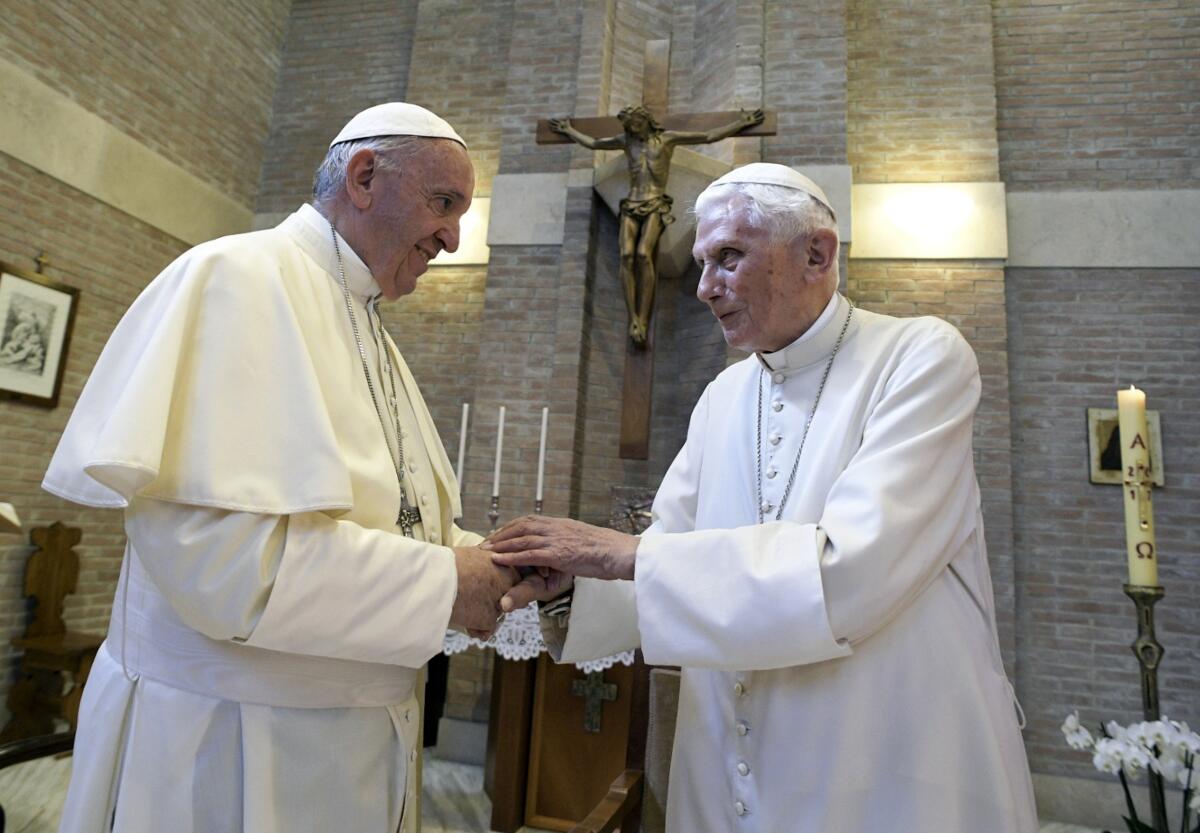
- Show more sharing options
- Copy Link URL Copied!
Pope Francis has exposed the political “maneuvers” used to sway votes during the two most recent elections of popes, while denying he is planning to reform the process for future conclaves, in a book-length interview published Tuesday.
The confidential revelations are contained in “The Successor: My Memories of Benedict XVI,” in which the Argentine pope reflects on his relationship with the late German pope and settles some scores with Benedict’s longtime aide.
The book, written as a conversation with the correspondent for Spain’s ABC daily, Javier Martínez-Brocal, comes at a delicate time for the 87-year-old Francis. His frail health has raised questions about how much longer he will remain pope, whether he might follow in Benedict’s footsteps and resign, and who might eventually replace him.
In the book, Francis revealed previously confidential details about the 2005 conclave that elected Benedict pope and the 2013 ballot in which he himself was elected, saying he was allowed to deviate from the cardinals’ oath of secrecy because he is pope.

World & Nation
Pope acknowledges criticism and health issues but says in new memoir he has no plans to retire
Pope Francis says he has no plans to step down and isn’t suffering from any health problems that would require him to do so.
March 16, 2024
In 2005, Francis said, he was “used” by cardinals who wanted to block the election of Benedict — then Cardinal Joseph Ratzinger — and that they managed to sway 40 out of 115 votes his way. The idea wasn’t to elect the Argentine but rather to force a compromise candidate after knocking Ratzinger out of the running, he said.
“They told me afterward that they didn’t want a ‘foreign’ pope,” — in other words, a non-Italian one — Francis said, making clear that the process wasn’t so much about the Holy Spirit inspiring cardinals as it was a cold, hard political calculus.
Francis said he put an end to the maneuvering by announcing that he wouldn’t accept being pope, after which Ratzinger was elected.
“He was the only one who could be pope in that moment,” Francis said, adding that he, too, voted for Ratzinger.
In 2013, after Benedict’s resignation, there was more political maneuvering. Francis — who at the time was Cardinal Jorge Mario Bergoglio — said he only realized after the fact that cardinals were coalescing behind him, pestering him with questions about the church in Latin America and dropping hints that he was gaining support.
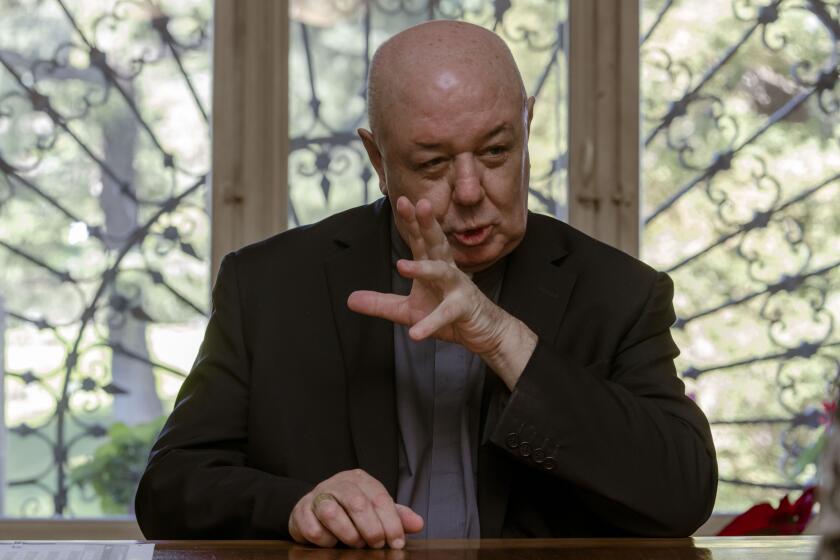
The keeper of the Vatican’s secrets is retiring. Here’s what he wants you to know
The longtime keeper of the Vatican Apostolic Archive is spilling the beans for the first time, revealing some of the secrets he uncovered over 45 years.
Feb. 19, 2024
He said it finally dawned on him that he might be pope when Spanish Cardinal Santos Abril y Castelló came running after him after lunch on March 13, just before what would become the final ballot.
The Spanish cardinal had what was clearly a health-related question about Bergoglio’s ability to take on the physical rigors of the papacy, after opponents apparently had raised his health as a possible impediment to his election.
“Eminence, is it true you’re missing a lung?” Francis recounted Abril as saying, to which he replied that he had part of one lung removed after a respiratory infection. After he assured the cardinal that the operation had taken place more than 50 years earlier, he remembered Abril muttering: “Oh these last-minute maneuvers…”
Francis in the interview denied rumors he is planning any reform of the conclave rules for a future papal election.
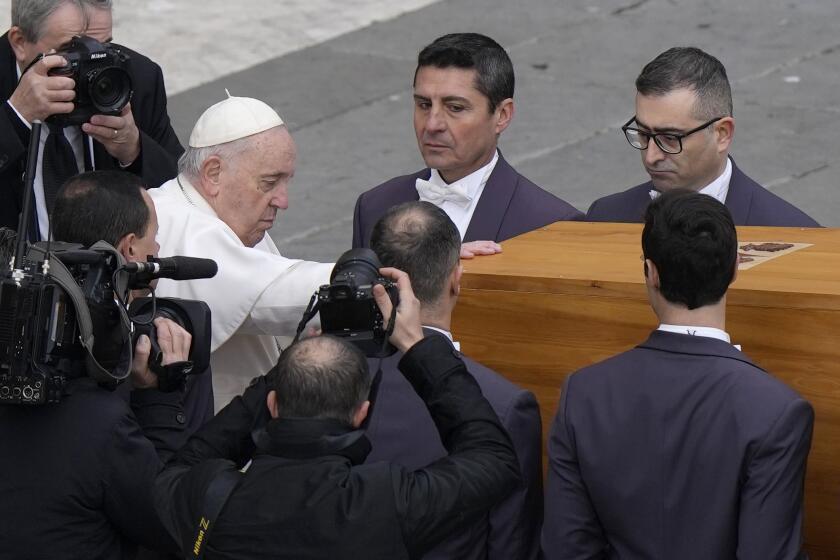
Thousands mourn Benedict XVI at a funeral presided over by Pope Francis
As bells tolled, thousands of people mourned Pope Emeritus Benedict XVI at a rare requiem Mass for a dead pontiff presided over by a living one.
Jan. 5, 2023
Conservative media have speculated, without any attribution, that Francis was tinkering with the protocols to limit pre-conclave discussions about the needs of the church to cardinals aged under 80. Only those cardinals — most of whom were appointed by Francis — are able to vote for the next pope, but older colleagues are currently allowed to take part in the earlier discussions.
While Francis denied any such reform, he revealed he was revising the protocol for papal funerals. Francis said Benedict’s would be “the last wake in which the body of a pope is exposed in an open coffin, on a bier.”
He said he wanted to ensure popes “are buried like any son of the church,” in a dignified, but not excessive manner.
In the book, Francis also settles some scores with Benedict’s longtime secretary, Archbishop Georg Gaenswein, whom he initially fired and then exiled from the Vatican after what he described as a series of imprudent decisions that “made life difficult for me.”
Retired Pope Benedict reemerges to step into the roiling clergy sex abuse debate
The former Pope Benedict XVI receives visitors at his secluded residence in the Vatican’s gardens, but if they gripe about his successor, Pope Francis, he is said to have a way of changing the subject.
April 14, 2019
Gaenswein is widely believed to have helped fuel the anti-Francis opposition during Benedict’s decade-long retirement, allowing Benedict to be used by conservatives nostalgic for his doctrinaire papacy. He was behind some of the biggest hiccups in the unusual cohabitation of two popes.
Francis reveals details about one well-known incident in 2020, in which Cardinal Robert Sarah, the conservative former Vatican liturgy chief, co-authored a book with Benedict reasserting the need for a celibate priesthood.
The book was published at the precise moment Francis was considering calls to relax celibacy requirements and allow married priests in order to address a shortage of clergy in the Amazon. It caused a stir because Benedict’s participation in the book raised the prospect of the former pope trying to influence the decision-making of a current one.
Francis squarely blames Gaenswein for the affair, insisting that Sarah was a “good man” who perhaps was “manipulated by separatist groups.” Francis said he felt compelled to sideline Gaenswein after the ruckus.

Pope Francis skips Palm Sunday homily at start of busy Holy Week that will test his health
Pope Francis has decided at the last minute to skip his homily during Palm Sunday Mass in St. Peter’s Square.
March 24, 2024
“I was obliged to ask Benedict’s secretary to take a voluntary leave, but keeping the title of prefect of the papal household and the salary,” Francis said.
Gaenswein later sealed his fate with Francis when he published a tell-all memoir, “Nothing But the Truth,” in the days after Benedict’s Dec. 31, 2022, death that was highly critical of Francis.
“It pained me that they used Benedict. The book was published on the day of his burial, and I felt it was a lack of nobility and humanity,” Francis said.
Francis insisted that Benedict always deferred to him, defended him and supported him and was not behind any of the conservative attacks or maneuvers to undermine his authority.
He denied that his dry homily during Benedict’s funeral, criticized by conservatives as lacking praise, was a sign of anything other than liturgical protocol.
“You don’t deliver eulogies in homilies,” he said.
Winfield writes for the Associated Press.
More to Read
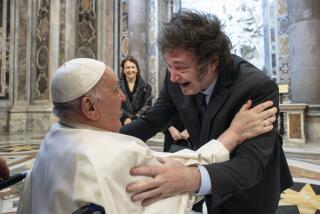
Pope and Argentine President Milei embrace after pontiff canonizes Argentina’s first female saint
Feb. 11, 2024

Pope Francis wants to be buried in Rome basilica, not in the Vatican
Dec. 13, 2023
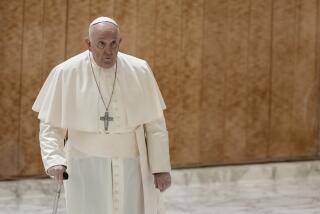
Pope ‘much better’ after bronchitis bout but still tires if he speaks too much
Dec. 6, 2023
Start your day right
Sign up for Essential California for news, features and recommendations from the L.A. Times and beyond in your inbox six days a week.
You may occasionally receive promotional content from the Los Angeles Times.
More From the Los Angeles Times
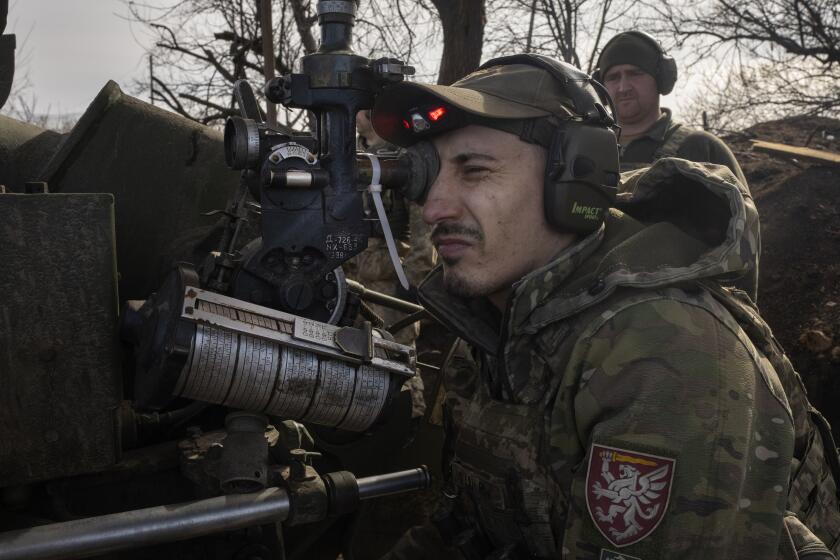
Ukraine’s parliament passes law to boost much-needed conscripts as war drags on

Dianne Feinstein made history. Now she could get honored with a post office?

Climate & Environment
Coastal salmon fishing banned for a second year amid steep population declines
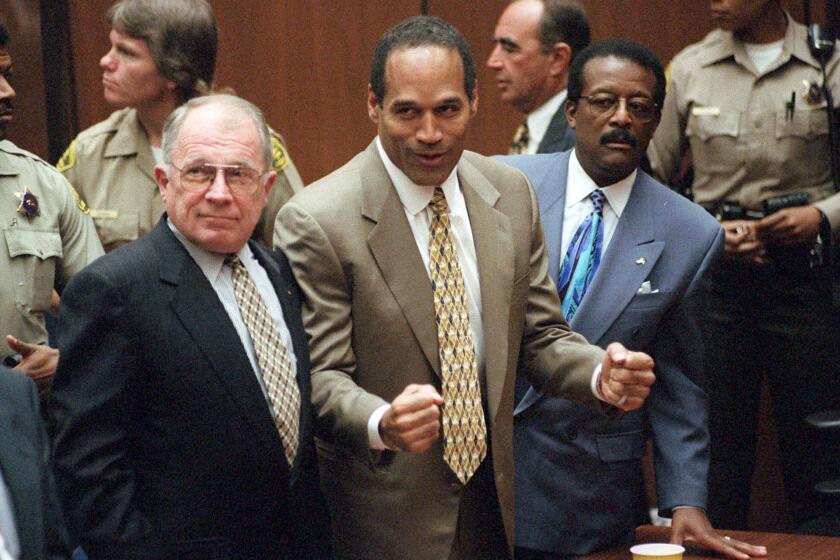
O.J. Simpson, former football star accused of murder, has died

Hi, what are you looking for?

Pope Francis grants plenary indulgences for National Eucharistic Pilgrimage, Congress participants
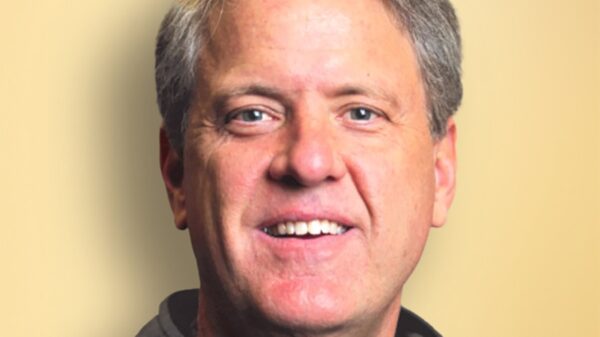
Charlotte, N.C., bishop resigns for health reasons; Franciscan named as successor
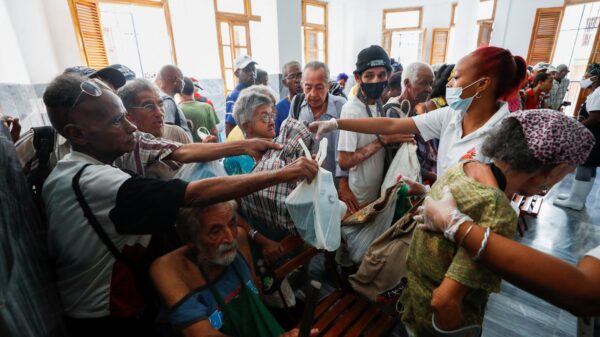
US Catholic pastoral leaders welcome Vatican document on human dignity
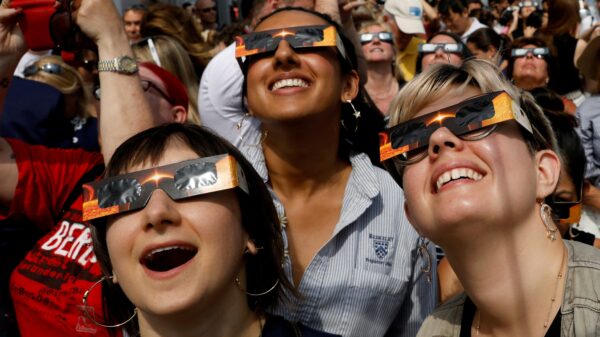
‘Awe-inspiring’ total solar eclipse offers chance ‘to reflect on God’s grandeur’
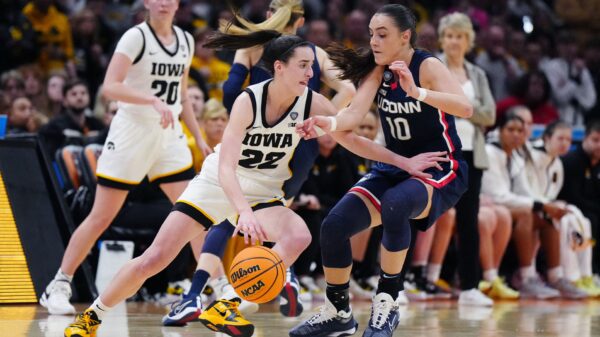
UPDATED: ‘Caitlin Clark has the world by her fingertips’: Iowa Hawkeyes basketball superstar supported by Catholic faith, family
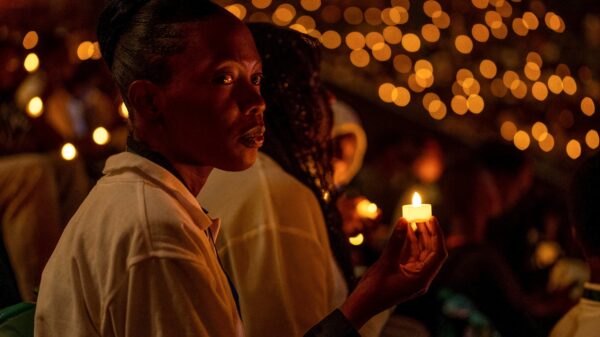
Bishops in Rwanda express their closeness to 1994 genocide survivors
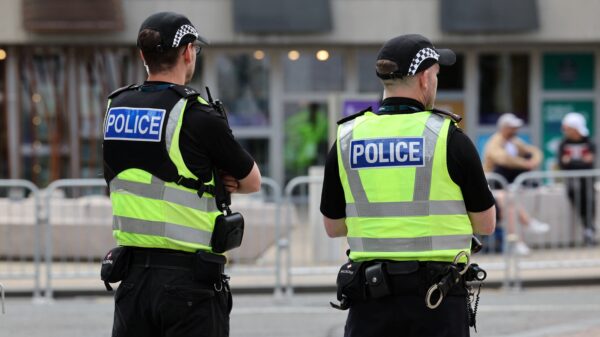
Could new hate speech law in Scotland target Christians?
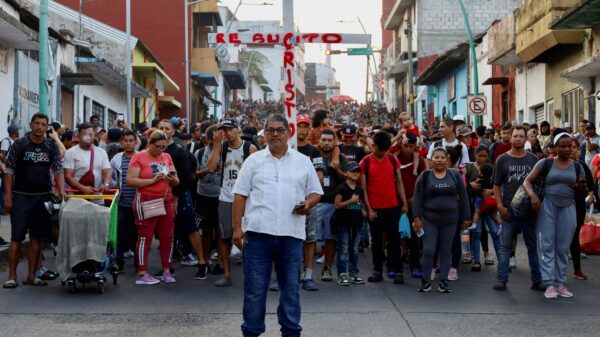
‘Viacrucis migrante’ caravan calls attention to plight of migrants during Holy Week
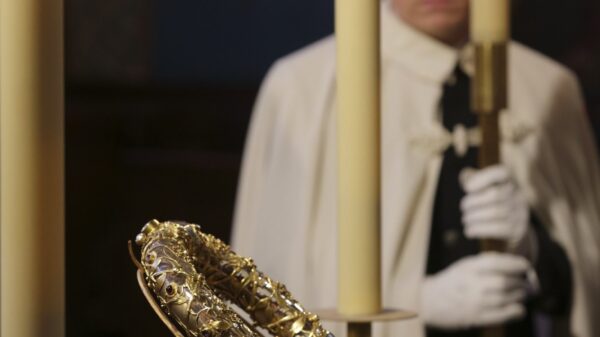
Next to it ‘I feel I’m not alone,’ says guardian of Jesus’ crown of thorns in Paris
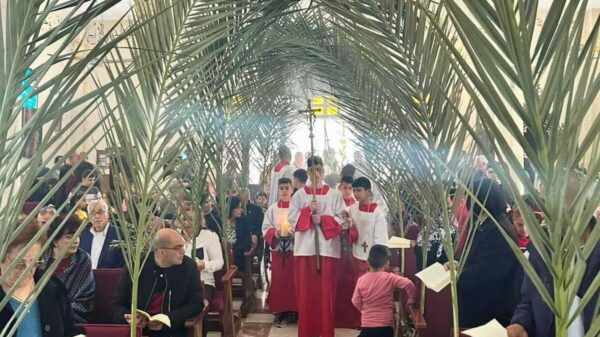
‘We are not alone, abandoned or afraid,’ says patriarch of Jerusalem on Palm Sunday
El Papa dice a sacerdotes latinoamericanos: Sean iconos de Cristo, sequen las lágrimas como la Verónica
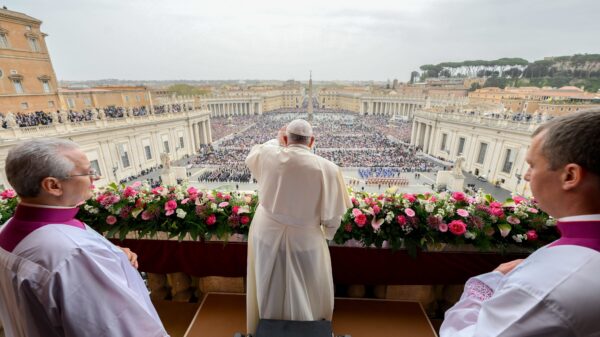
En Pascua, el Papa pide a Cristo que ‘haga rodar’ las piedras de la guerra en todo el mundo
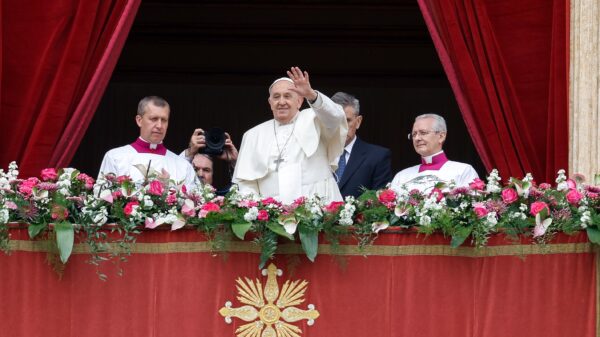
On Easter, pope asks Christ to ‘roll away’ the stones of war worldwide
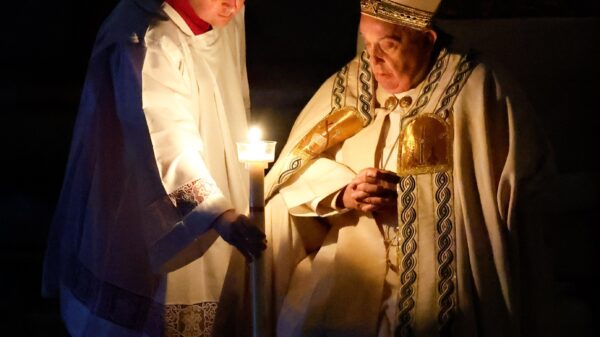
La Pascua marca el ‘renacimiento de la esperanza entre los escombros del fracaso’, dice el Papa
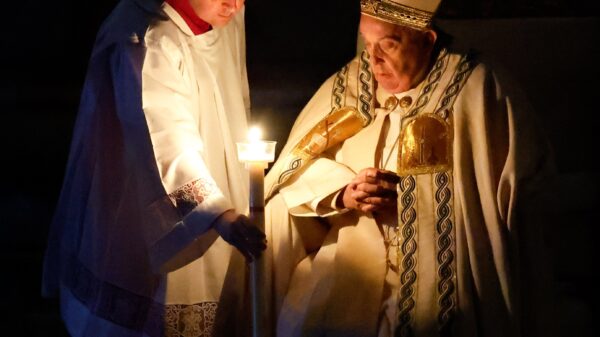
Easter marks the ‘rebirth of hope amid the ruins of failure,’ pope says
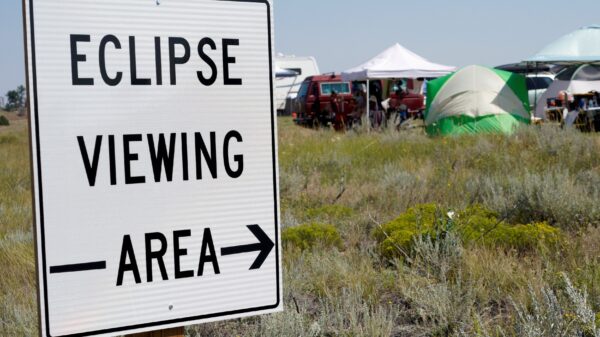
OSV News Showcase | April 5, 2024

Let’s celebrate Easter for a while
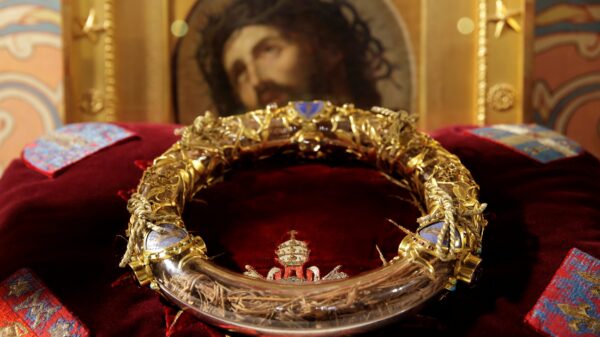
OSV News Showcase | March 29, 2024
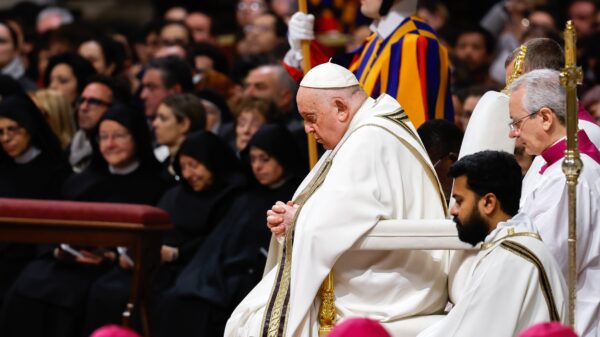
The Year of Mercy was instructive; the Year of Prayer may be immersive
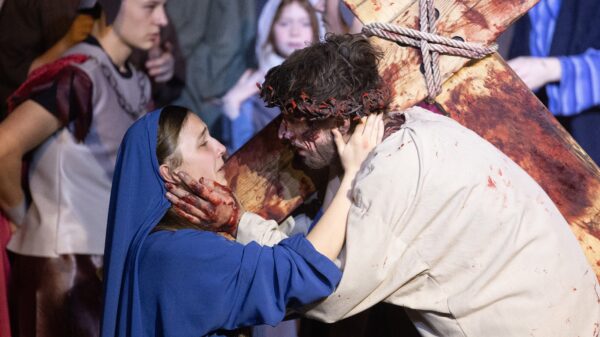
OSV News Showcase | March 22, 2024
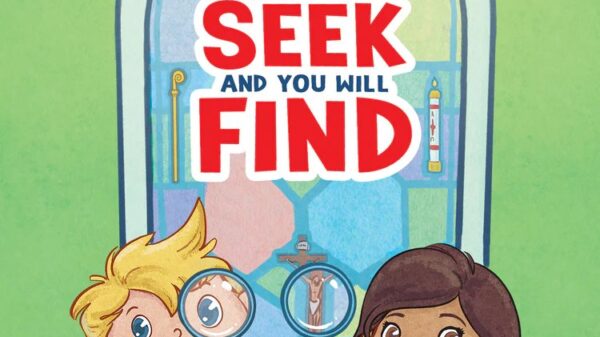
Embark with your child on a ‘Catholic Sacraments Adventure’
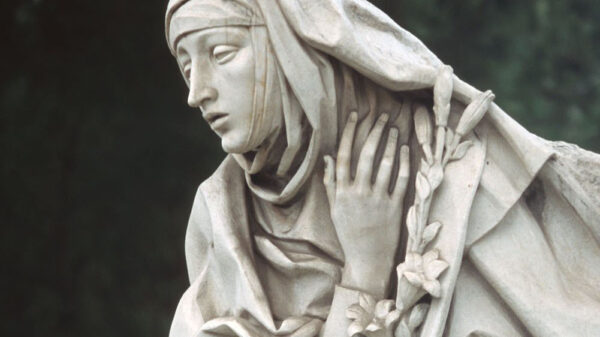
Entering into a ‘Dialogue’ with the loving and merciful Lord
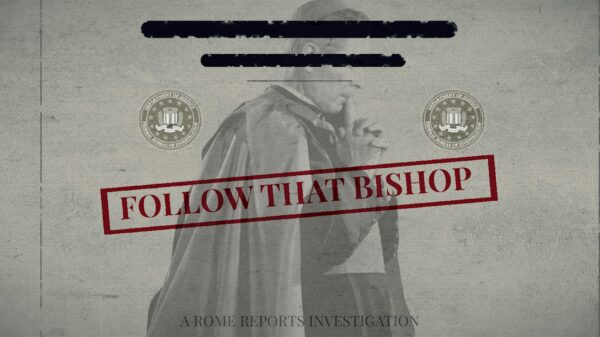
Documentary covers FBI file kept on Archbishop Sheen
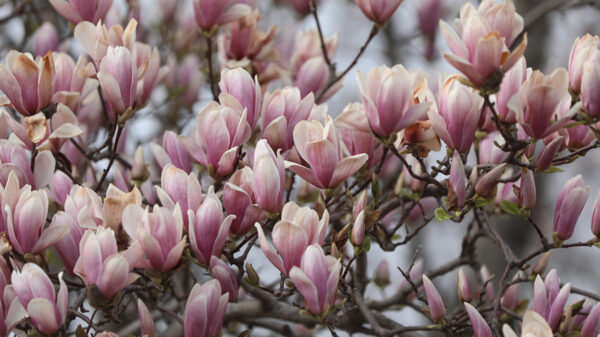
The loving challenge of the practice of the presence of God
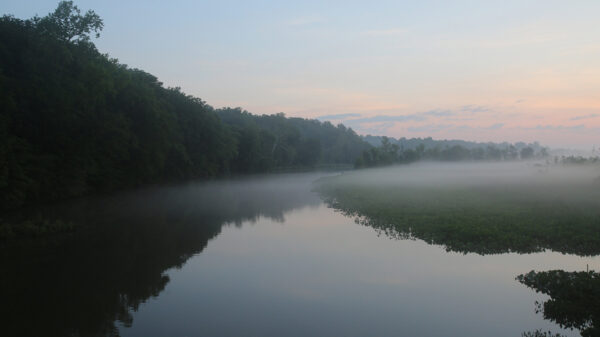
Enchanted by Waters: Annie Dillard’s ‘Pilgrim at Tinker Creek’ after 50 Years
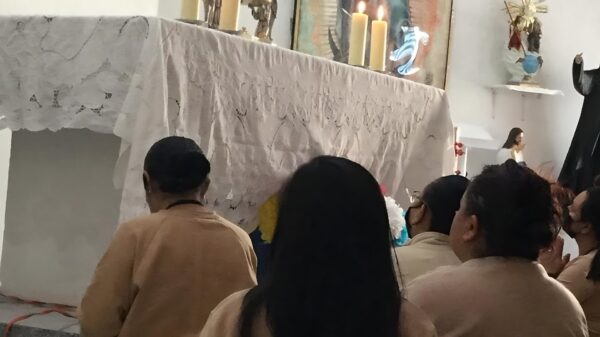
Retiros de Emaús en las cárceles, una misión evangelizadora que toca y cambia corazones
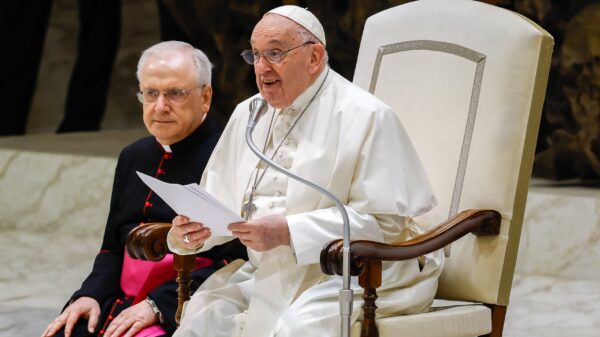
El Papa insta a tener paciencia, incluso en medio de la guerra, durante la audiencia de Semana Santa
- Client Login
Pope Benedict’s 2008 U.S. visit a whirlwind with timely, pointed messages
By Mark Pattison
WASHINGTON (CNS) — When Pope Benedict came to the United States for a visit to Washington and New York spanning six days in mid-April 2008, some news accounts called the pace of his schedule “grueling.”
Pope Benedict handled the pace with good grace while getting his message out to millions of Catholics both in the United States and throughout the world. He died at the Vatican Dec. 31.
The trip had been timed to help celebrate the bicentennials of four archdioceses in the United States: New York, Boston, Philadelphia, and Louisville, Kentucky. They were erected from the Baltimore Diocese, the nation’s first diocese, which was elevated to an archdiocese in the same year, 1808.
But it was the abuse crisis, which burst onto front pages in 2002 and persists to this day, that was a central focus of Pope Benedict’s trip; this was the first papal visit since the scandal started making headlines in the U.S.
At a Mass at the brand new Nationals Park in Washington, Pope Benedict said that “no words of mine could describe the pain and harm inflicted by such abuse. It is important that those who have suffered be given loving pastoral attention.”
The pope lauded the efforts to deal “honestly and fairly with this tragic situation and to ensure that children — whom Our Lord loves so deeply and who are our greatest treasure — can grow up in a safe environment.”
“I encourage each of you to do what you can to foster healing and reconciliation and to assist those who have been hurt. Also, I ask you to love your priests, and to affirm them in the excellent work that they do,” he said.
Later that day, he met privately with a group of abuse survivors at the apostolic nunciature; the meeting was a first for a pope.
Pope Benedict’s Washington itinerary included an audience with the U.S. bishops and an appearance at The Catholic University of America, the nation’s papally chartered university, to speak to educators. He also presided over a vespers service at the Basilica of the Shrine of the Immaculate Conception.
The pope met with President George W. Bush inside the White House, emerging to cheering throngs outside as the pope and the president exchanged greetings.
In his meeting with the bishops, Pope Benedict acknowledged the “evil” of the clerical sexual abuse crisis and encouraged them to continue their work to restore trust in the church and its ministers.
Talking to educators at The Catholic University of America, he said today’s challenges require sound instruction in the faith, especially among the young. But they also call for “cultivating a mindset, an intellectual culture, which is genuinely Catholic” and can bring the Gospel to bear on the urgent issues American society faces.
Before heading to New York, Pope Benedict met with 200 representatives of Islam, Jainism, Buddhism, Hinduism and Judaism gathered at the Pope John Paul II Cultural Center, and on his way to an ecumenical prayer service in Manhattan, Pope Benedict stopped to greet Jewish leaders at the Park East Synagogue.
At the synagogue, Pope Benedict expressed his respect for the city’s Jewish community and encouraged the building of “bridges of friendship” between religions. The encounter marked the first time a pope had visited a Jewish place of worship in the United States, and it came a day before the start of Passover.
At the ecumenical prayer service, Pope Benedict said the witness of Christians in the world is weakened not only by their divisions, but also by some communities turning their backs on Christian tradition.
“Too often those who are not Christians, as they observe the splintering of Christian communities, are understandably confused about the Gospel message itself,” he said.
He also praised the ecumenical commitment of U.S. Christians and acknowledged that the agreements found in their theological dialogues have contributed to the theological agreements later forged by the Vatican and its official dialogue partners.
Celebrating Mass in New York’s St. Patrick’s Cathedral with thousands of priests and religious, the pope urged the Catholic Church in the United States to move past divisions and scandal toward a “new sense of unity and purpose.” It is time, he said, to “put aside all anger and contention” inside the church and embark on a fresh mission of evangelization in society.
Honoring the bicentennial of four U.S. archdioceses, Pope Benedict praised the “solid foundations” of the American Catholic Church and said that “the future of the church in America” must continue to build on that “impressive legacy.”
But in his homily for the final U.S. Mass, celebrated at Yankee Stadium, he also said the “impressive growth” of the U.S. church has been “not without its challenges,” comparing those challenges to the “linguistic and cultural tensions” found in the early church.
“In these 200 years, the face of the Catholic community in your country has changed greatly,” Pope Benedict said. “We think of the successive waves of immigrants whose traditions have so enriched the church in America.”
He also lauded “the strong faith which built up the network of churches, educational, health care and social institutions which have long been the hallmark of the church in this land,” as well as “those countless fathers and mothers who passed on the faith to their children, the steady ministry of the many priests who devoted their lives to the care of souls, and the incalculable contribution made by so many men and women religious.”
In a speech to the U.N. General Assembly, Pope Benedict said neither government nor religion has a right to change or limit human rights, because those rights flow from the dignity of each person created in God’s image. The pope insisted that human rights cannot be limited or rewritten on the basis of national interests or majority rule.
He also said the role of religions is not to dictate government policy, but to help their members strive to find the truth, including the truth about the dignity of all people, even if their religious views are different.
Two years after his U.S. visit, Pope Benedict sat down for an interview with German journalist Peter Seewald. The interview became the basis for a book, “Light of the World: The Pope, the Church and the Signs of the Times.”
Speaking of the visit, when the abuse crisis was center stage, Pope Benedict said: “I think even non-Catholics were surprised that the visit was not some kind of challenge.”
The pope said that at every appointment on his trip, including the liturgies in New York and Washington, there was “joyful participation, a sense of closeness, of communion, that touched me greatly.”
Asked whether the church in the United States had already surmounted the abuse crisis, Pope Benedict replied, “That might be an exaggeration.” But, he added, the crisis made the U.S. church in the United States “aware of its fragility and of the problems and sin that are present in it. This is very important. In addition, there is an internal awakening to the need to overcome all these things and to live out and embody Catholic identity in new ways in our time.”

Detroit Auxiliary Bishop Gumbleton, promoter of solidarity with those in need, dies at 94
You may also like.
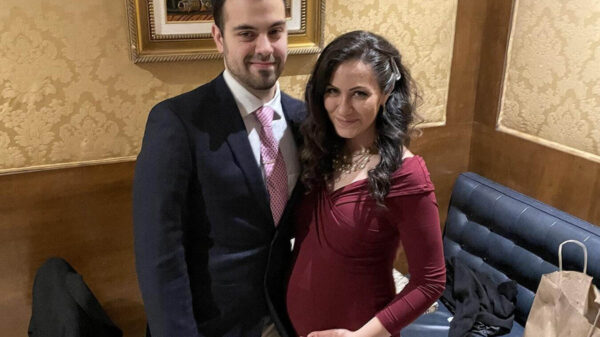
Pregnant with conjoined twins, Detroit mother finds powerful strength in faith
By Karla Fierro DETROIT (OSV News) — Nicole Duque, 23, has always desired to become a mother. She was born and raised in the...
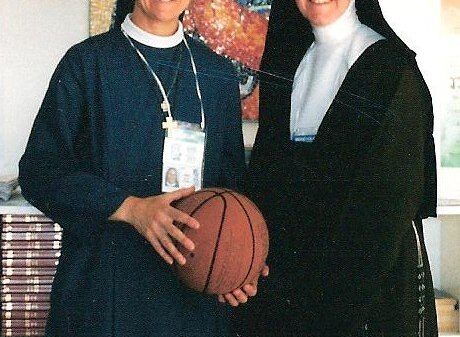
Basketball sisters now play for God: College teammates head out on different paths, wind up on same journey 40 years later
By Linda Reeves MIAMI (OSV News) — Divine intervention may be the only explanation for how two college teammates graduated, ventured off on different...
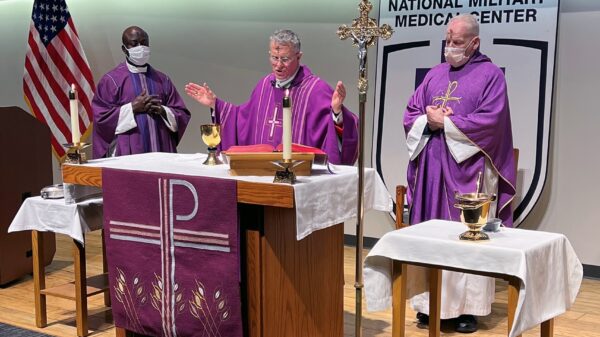
Walter Reed decision to cancel Catholic pastoral contract ahead of Holy Week ‘incomprehensible,’ says US military archbishop
BETHESDA, Md. (OSV News) — Archbishop Timothy P. Broglio of the U.S. Archdiocese for Military Services has called a decision by a U.S. military...

Bishops add some spiritual ‘meat’ to St. Patrick’s Day dispensations
(OSV News) — With St. Patrick’s Day falling on a Lenten Friday this year, many U.S. bishops have issued dispensations from abstinence on March...
- Asia - Pacific
- Middle East - Africa
- Apologetics
- Benedict XVI
- Catholic Links
- Church Fathers
- Life & Family
- Liturgical Calendar
- Pope Francis
- CNA Newsletter
- Editors Service About Us Advertise Privacy

Pope Francis: I was ‘used’ against Ratzinger in 2005 conclave, but he was ‘my candidate’
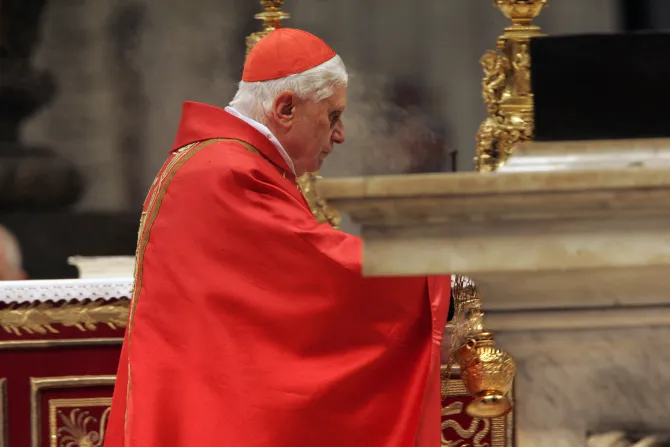
By Jonathan Liedl
CNA Staff, Apr 1, 2024 / 13:30 pm
Pope Francis said he was “used” in the 2005 conclave in an effort to block the election of Cardinal Joseph Ratzinger, though he supported the candidacy of the man who soon became Pope Benedict XVI.
“He was my candidate,” Francis said of his predecessor in excerpts from the forthcoming book “The Successor,” published by the Spanish newspaper ABC on Easter Sunday.
In the book, Pope Francis told Spanish journalist Javier Martínez-Brocal that his name, then-Cardinal Jose Mario Bergoglio of Buenos Aires, was put forward as part of a “complete maneuver” by an unnamed group of cardinals to manipulate the conclave’s outcome.
“The idea was to block the election of [Ratzinger],” he explained. “They were using me, but behind them they were already thinking about proposing another cardinal. They still couldn’t agree on who, but they were already on the verge of throwing out a name.”
Francis said that at one point of the conclave, which began on April 18, 2005, he was receiving 40 of the 115 total votes. If cardinals continued to support him, Ratzinger would not have reached the necessary two-thirds threshold to be elected, likely prompting a search for an alternative candidate.
Francis said that he realized the “operation” was afoot on the second day of voting and told the Colombian Cardinal Dario Castrillón to not “joke with my candidacy” and cease supporting him, “because I’m not going to accept” being elected.
Austen Ivereigh, the pope’s English-speaking biographer, has previously written that Bergoglio, “almost in tears,” had begged not to be elected.
Ratzinger, who had been the longtime prefect of the Congregation for the Doctrine of the Faith under Pope John Paul II, was elected that same day.
Pope Francis did not say who this group of conclave manipulators consisted of nor who they planned to introduce as a third candidate, but the Argentinian prelate said that the group of cardinals “did not want a ‘foreign’ pope.”
Several accounts from the time have claimed that a group of liberal European cardinals, known as the Saint Gallen Group, attempted to manipulate the outcome of the 2005 conclave. Three members of the group, German Cardinals Walter Kasper and Karl Lehmann and Belgian Cardinal Godfried Danneels, also participated in the 2013 conclave that elected Francis. According to Ivereigh, they advocated for Bergoglio after first securing his assent, a claim the cardinals have denied.
According to Universi Dominici Gregis , an apostolic constitution governing papal conclaves, cardinal electors must refrain from “any form of pact, agreement, promise, or other commitment of any kind which could oblige them to give or deny their vote to a person or persons” under threat of automatic excommunication.
Conclave proceedings are, by definition, secretive, as the term is derived from a Latin word that means a “locked room.” But in “The Successor,” Francis said that while cardinals are sworn to secrecy regarding conclave proceedings, “the popes have license to tell it.”
Pope Francis also revealed that while others were putting his name forward in the hopes of forcing a stalemate, he believed Ratzinger “was the only one at that time [who] could be pope.”
“After the revolution of John Paul II, who had been a dynamic pontiff, very active, with initiative who traveled … there was a need for a pope who maintained a healthy balance, a transitional pope,” the Holy Father said of his predecessor, who served from 2005 to 2013.
Francis also said that he left Rome happy that Ratzinger had been elected and not himself.
“If they had chosen someone like me, who makes a lot of trouble, I wouldn’t have been able to do anything,” he said. “At that time, it would not have been possible.”
Nonetheless, Pope Francis added that the papacy “wasn’t easy” for Benedict XVI, who “encountered a lot of resistance within the Vatican.”
More in Vatican
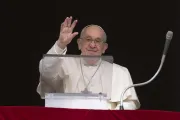
Pope Francis: The resurrection of Jesus changes our lives completely and forever
Pope Francis was also asked what the Holy Spirit was saying to the Church through the election of Benedict XVI.
“’I am in charge here,’” Francis said of the Spirit’s response. “’There is no room for maneuver.’”
“The Successor” is part of a flurry of Francis-focused books being released in the 87-year-old Jesuit’s 11th year as pontiff, which also includes “Life: My Story Through History,” the pope’s first autobiography.
The new book, which focuses on the relationship between Pope Francis and Benedict XVI, is set to be published in Spanish on Wednesday, April 3, with no details yet available on an English edition.
- Catholic News ,
- Pope Francis ,
- Joseph Ratzinger ,
- Pope Emeritus Benedict XVI ,
- Vatican news

Subscribe to our daily newsletter
Our mission is the truth. join us.
Your monthly donation will help our team continue reporting the truth, with fairness, integrity, and fidelity to Jesus Christ and his Church.
You may also like
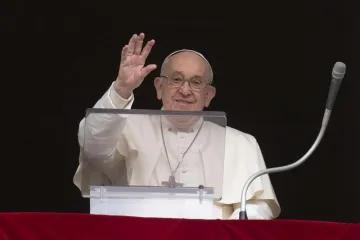
“Brothers, sisters, the joy of the Resurrection is not something far away. It is very close; it is ours because it was given to us on the day of our baptism.”
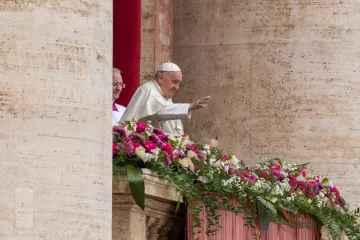
Full text of Pope Francis’ urbi et orbi blessing for Easter 2024
Here is the full text of the pope’s urbi et orbi message and blessing from the central loggia of St. Peter’s Basilica on the morning of Easter Sunday 2024.
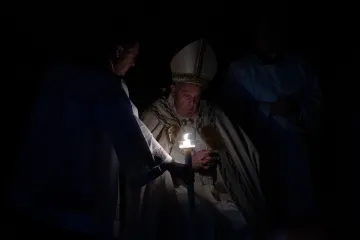
Pope Francis at Easter Vigil: Christ ‘is the one who brings us from darkness into light’
“This is the Pasch of Christ, the revelation of God’s power: the victory of life over death, the triumph of light over darkness,” the pope said on Saturday.
Benedict backed me up on rights for LGBTQ couples, Pope Francis says
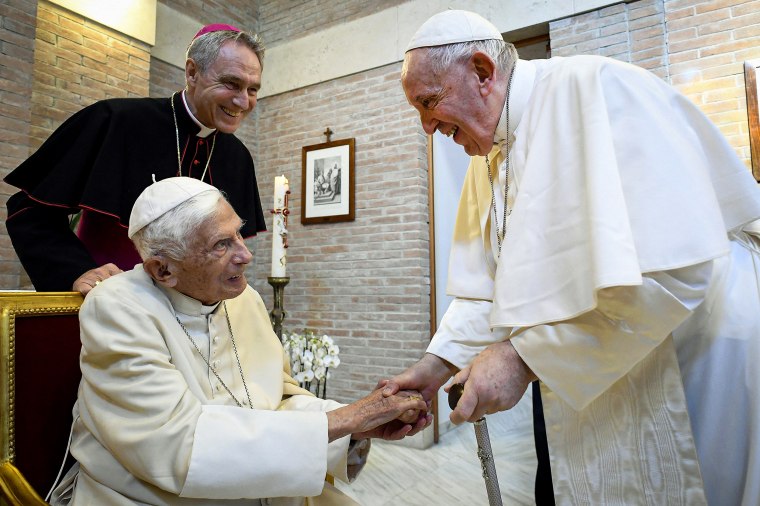
VATICAN CITY — Pope Francis found an ally in his predecessor Benedict XVI when he spoke in favor of civil partnerships for same-sex couples, the pontiff said in a new book due out in Spain.
The work is set for publication on Wednesday, but its contents were shared in advance on Tuesday with several media, including Reuters.
Francis has confirmed the Catholic Church’s opposition to LGBTQ marriages, but has repeatedly said same-sex couples have a right to be protected by civil union laws.
A greater openness towards the LGBTQ community has been one of the hallmarks of his 11-year papacy, but the more conservative Benedict was not known as sympathetic to the cause.
Nevertheless, Francis said Benedict stood up for him before an unnamed group of cardinals who had gone to him to complain about the pope’s “heresies” on civil partnerships.
“They showed up at his home to practically put me on trial and they accused me in front of him of backing same-sex marriage,” Francis said.
Benedict XVI listened, “helped them distinguish things” and told them that what Francis had said was “no heresy,” the pope said.
Francis made the revelation in the Spanish-language book “Pope Francis. The Successor: My memories of Benedict XVI,” based on interviews with journalist Javier Martinez-Brocal.
Already in February 2023, the pope had said that Benedict once dismissed a complaint about what Francis said on civil unions, but offered fewer details.
Same-sex blessings
In December, Francis allowed priests to bless same-sex couples , sparking conservative outrage, insisting this did not amount to a formal approval for non-heterosexual relationships.
There is no suggestion that Francis discussed that move with Benedict, who continued living in the Vatican after his shock decision to retire in 2013, until his death in late 2022.
In the book, Francis denied there were ever any personal frictions with his predecessor during the unprecedented so-called “two popes” period.
He confirmed he had a difficult relationship with Benedict’s secretary, Archbishop Georg Gaenswein, who released a critical book on Francis just hours after Benedict’s burial.
“To publish a book that lays into me on the day of the funeral, telling things that are not true, is very sad,” Francis said.
Francis, who is 87 and in increasingly frail health, also talked about his funeral plans, confirming plans to simplify burial rites for him and his successors.
The bodies of dead popes will no longer be exposed, lying in state, before being placed in a coffin, as has been done for Benedict and previous pontiffs, he said.
Benedict Backed Me up on Rights for LGBT Couples, Pope Francis Says

FILE PHOTO: Pope Francis and Pope Emeritus Benedict XVI attend a meeting on the day of a consistory ceremony to elevate Roman Catholic prelates to the rank of cardinal, at the Vatican, August 27, 2022. Vatican Media/Handout via REUTERS/File Photo
By Alvise Armellini
VATICAN CITY (Reuters) - Pope Francis found an ally in his predecessor Benedict XVI when he spoke in favour of civil partnerships for same-sex couples, the pontiff said in a new book due out in Spain.
The work is set for publication on Wednesday, but its contents were shared in advance on Tuesday with several media, including Reuters.
Francis has confirmed the Catholic Church's opposition to LGBT marriages, but has repeatedly said same-sex couples have a right to be protected by civil union laws.
A greater openness towards the LGBT community has been one of the hallmarks of his 11-year papacy, but the more conservative Benedict was not known as sympathetic to the cause.
Nevertheless, Francis said Benedict stood up for him before an unnamed group of cardinals who had gone to him to complain about the pope's "heresies" on civil partnerships.
Photos You Should See - April 2024

"They showed up at his home to practically put me on trial and they accused me in front of him of backing same-sex marriage," Francis said.
Benedict XVI listened, "helped them distinguish things" and told them that what Francis had said was "no heresy", the pope said.
Francis made the revelation in the Spanish-language book "Pope Francis. The Successor: My memories of Benedict XVI", based on interviews with journalist Javier Martinez-Brocal.
Already in February 2023, the pope had said that Benedict once dismissed a complaint about what Francis said on civil unions, but offered fewer details.
SAME-SEX BLESSINGS
In December, Francis allowed priests to bless same-sex couples, sparking conservative outrage, insisting this did not amount to a formal approval for non-heterosexual relationships.
There is no suggestion that Francis discussed that move with Benedict, who continued living in the Vatican after his shock decision to retire in 2013, until his death in late 2022.
In the book, Francis denied there were ever any personal frictions with his predecessor during the unprecedented so-called "two popes" period.
He confirmed he had a difficult relationship with Benedict's secretary, Archbishop Georg Gaenswein, who released a critical book on Francis just hours after Benedict's burial.
"To publish a book that lays into me on the day of the funeral, telling things that are not true, is very sad," Francis said.
Francis, who is 87 and in increasingly frail health, also talked about his funeral plans, confirming plans to simplify burial rites for him and his successors.
The bodies of dead popes will no longer be exposed, lying in state, before being placed in a coffin, as has been done for Benedict and previous pontiffs, he said.
(This story has been corrected to change the book publication day from Tuesday to Wednesday, in paragraph 2)
(Reporting by Alvise Armellini, editing by Sharon Singleton)
Copyright 2024 Thomson Reuters .
Join the Conversation
Tags: Argentina , Christianity , Italy , Europe , Spain , Germany
America 2024

Health News Bulletin
Stay informed on the latest news on health and COVID-19 from the editors at U.S. News & World Report.
Sign in to manage your newsletters »
Sign up to receive the latest updates from U.S News & World Report and our trusted partners and sponsors. By clicking submit, you are agreeing to our Terms and Conditions & Privacy Policy .
You May Also Like
The 10 worst presidents.
U.S. News Staff Feb. 23, 2024

Cartoons on President Donald Trump
Feb. 1, 2017, at 1:24 p.m.

Photos: Obama Behind the Scenes
April 8, 2022

Photos: Who Supports Joe Biden?
March 11, 2020

A Reprieve for Inflation?
Tim Smart April 11, 2024

Embattled Johnson Bruised Again
Aneeta Mathur-Ashton April 10, 2024

What to Know About Biden's State Dinner
Laura Mannweiler April 10, 2024

Fed: Inflation Path ‘Somewhat Uneven’
Tim Smart April 10, 2024

No Letup From Inflation in March

Arizona Court Upholds 1864 Abortion Ban
Lauren Camera April 9, 2024


COMMENTS
St. Louis, Mo., Jan 2, 2023 / 10:00 am. Pope Benedict XVI, who died Saturday, visited the United States only once, but he left a lasting impression. The spring 2008 trip included a Mass celebrated ...
The visit was announced on November 12, 2007 by Archbishop Pietro Sambi to the U.S. Conference of Catholic Bishops.. Visit April 15 (Washington) Pope Benedict arrives at Andrews Air Force Base President Bush greets Pope Benedict XVI at Andrews Air Force Base. The Pope arrived at Andrews Air Force Base outside Washington on April 15, 2008, greeted by President Bush and cheering crowds.
(15 Apr 2008) SHOTLIST1. Pope Benedict XVI's plane on runway 2. US President George W. Bush, First Lady Laura Bush and their daughter Jenna walking to meet...
April 20, 2008 • Pope Benedict XVI concluded his U.S. visit today with a tour of New York City. The pontiff stopped this morning at Ground Zero and gave a blessing at the site of the Sept. 11 ...
WASHINGTON (CNS) — When Pope Benedict came to the United States for a visit to Washington and New York spanning six days in mid-April 2008, some news accounts called the pace of his schedule "grueling.". Pope Benedict handled the pace with good grace while getting his message out to millions of Catholics both in the United States and ...
Pope Benedict XVI concluded his six-day visit to the United States with a final address Sunday, thanking Americans for their hospitality and calling on people worldwide to pursue "justice and ...
April 20, 2008 marked the conclusion of the late Pope Benedict XVI's historic six-day pilgrimage to the United States, which included spending the last three days in the Empire State.
When Pope Benedict came to the United States for a visit to Washington and New York spanning six days in mid-April 2008, some news accounts called the pace of his schedule "grueling." Pope Benedict handled the pace with good grace while getting his message out to millions of Catholics both in the United States and throughout the world.
WASHINGTON | When Pope Benedict came to the United States for a visit to Washington and New York spanning six days in mid-April 2008, some news accounts called the pace
Pope Benedict XVI speaks to members of the press on board his flight to the United States on April 15, 2008. May 6, 2008. Before the pope's plane - dubbed "Shepherd One" - touched down at Andrews Air Force Base on April 15, the news media portrayed Pope Benedict XVI as a largely unknown religious figure about to introduce himself to American Catholics still recovering from the clergy ...
to the united states of america and visit to the united nations organization headquarters. meeting with the members of the general assembly of the united nations organization. address of his holiness benedict xvi* new york friday, 18 april 2008 . mr president, ladies and gentlemen,
Pope John Paul II. With five official visits to the United States and two stopovers in Alaska, John Paul II visited the country more than any other Holy Father. "He was very much a pope on a ...
On April 18, 2005, Cardinal Joseph Ratzinger was elected the 264th successor of Saint Peter and chose the name Benedict XVI. His papacy testifies to both a scholarly churchman, having extensively studied theology and philosophy, and pastoral sensitivity. When elected pope at age 78, he didn't anticipate traveling the globe given his age and ...
Benedict XVI (born April 16, 1927, Marktl am Inn, Germany—died December 31, 2022, Vatican City) was the bishop of Rome and head of the Roman Catholic Church from 2005 to 2013. Prior to his election as pope, Benedict led a distinguished career as a theologian and as prefect of the Congregation for the Doctrine of the Faith.
Back in April 2008, then Pope Benedict XVI's visited the United States in what was a highly anticipated event, one that marked the first visit to the country by a pope in seven years. The Pope ...
While visiting the United States on 17 April 2008, Benedict met with International Society for Krishna Consciousness representative Radhika ... In 2009, he visited Africa (Cameroon and Angola) for the first time as pope. During his visit, he suggested that altering sexual behaviour was the answer to Africa's AIDS crisis and urged Catholics ...
The Pope visited the United States from April 15 to April 20, 2008. ... 2009 that there was a possibility that Pope Benedict XVI would visit Malta the following year in connection with the 1950th anniversary of the Shipwreck of St Paul on the Maltese islands.
The first reigning pontiff to visit the United States was Pope Paul VI, who made a one-day stop in New York to address to the United Nations in 1965. ... Pope Benedict XVI with President George W ...
The last papal visit came in 2008, when Pope Benedict XVI stopped in New York and Washington. ... As the first pontiff to visit the United States, Pope Paul VI spent 13 and a half hours in New ...
By Mark Knoller. September 21, 2015 / 9:36 PM EDT / CBS News. WASHINGTON - More than seven years have passed since the last visit to the U.S. by a pope. In that same period of time British prime ...
Pope Francis will make his first visit to the United States in September, with stops in Washington, New York and Philadelphia. His trip will add to the 50-year history of pope visits to the U.S. Pope Paul VI made the first papal visit to the U.S. in October 1965. He addressed the United Nations General Assembly, attended the New York World's ...
VATICAN CITY (CNS) -- For the nearly 10 year s that Pope Francis and retired Pope Benedict XVI lived on opposite sides of St. Peter's Basili ca, th e two popes' relationship was marked by a deep mutual respect and profound sense of solidarity, Pope Francis said.. The retired pope, he said, would even defend Pope Francis before his critics. In a book-length interview, "El Sucesor" ("The Succ ...
When Pope Francis had the titles re-labeled, Matteo Bruni, director of the Vatican press office, told Catholic News Service that unlike in 2006 when Pope Benedict XVI had the title "Patriarch of ...
FILE - Pope Francis salutes Pope Emeritus Benedict XVI, left, at the end of a consistory in the St. Peter's Basilica at the Vatican, on Feb. 22, 2014. Pope Francis has exposed the political "maneuvers" to sway votes during the past two conclaves and denied he is planning to reform the process to elect a pope in a new book-length interview ...
Pope Francis, left, and Pope Benedict XVI greet each other in 2017. Francis reflects on his relationship with the late pope in "The Successor: My Memories of Benedict XVI."
WASHINGTON (CNS) — When Pope Benedict came to the United States for a visit to Washington and New York spanning six days in mid-April 2008, some news accounts called the pace of his schedule "grueling.". Pope Benedict handled the pace with good grace while getting his message out to millions of Catholics both in the United States and ...
CNA Staff, Apr 1, 2024 / 13:30 pm. Pope Francis said he was "used" in the 2005 conclave in an effort to block the election of Cardinal Joseph Ratzinger, though he supported the candidacy of ...
Pope Francis visited Pope Emeritus Benedict XVI in St. Peter's Basilica on Aug. 27, 2022. ABACAVatican Media / ABACA via Reuters file
US News is a recognized leader in college, grad school, hospital, mutual fund, and car rankings. ... Pope Francis and Pope Emeritus Benedict XVI attend a meeting on the day of a consistory ...